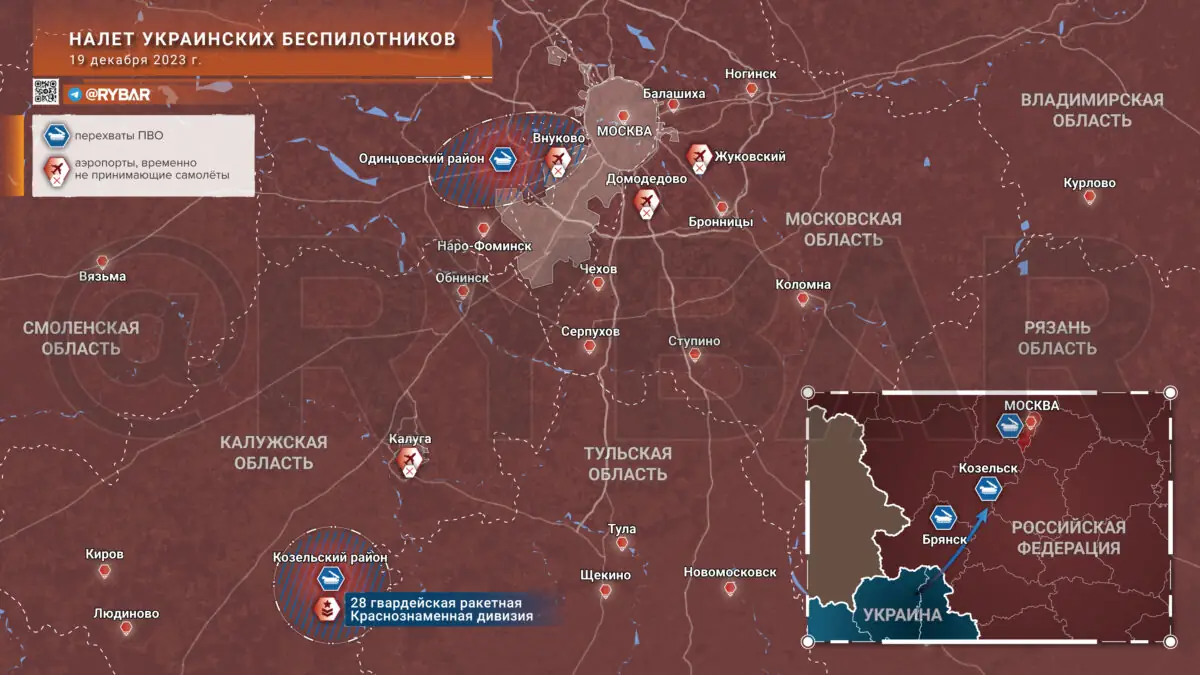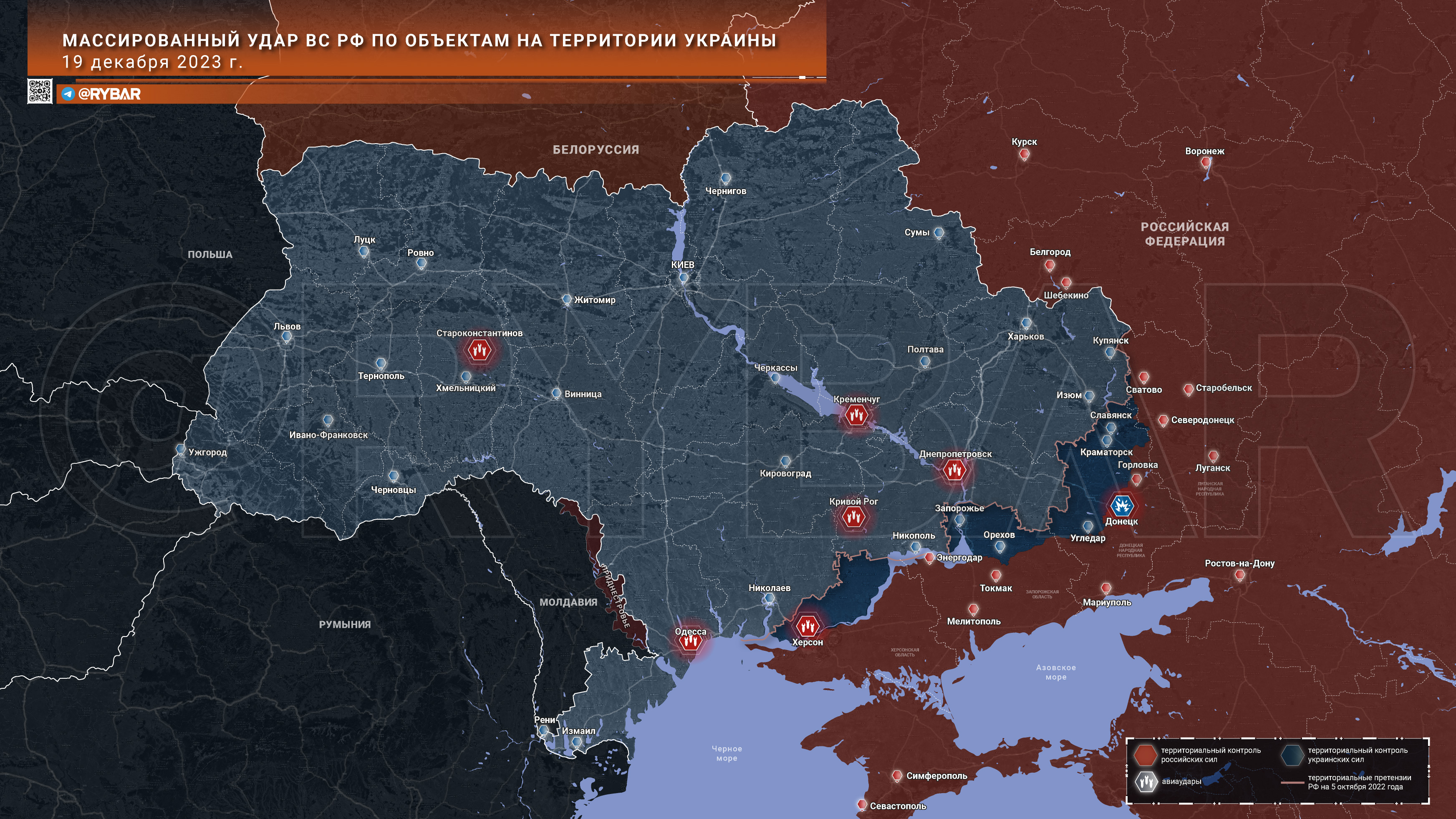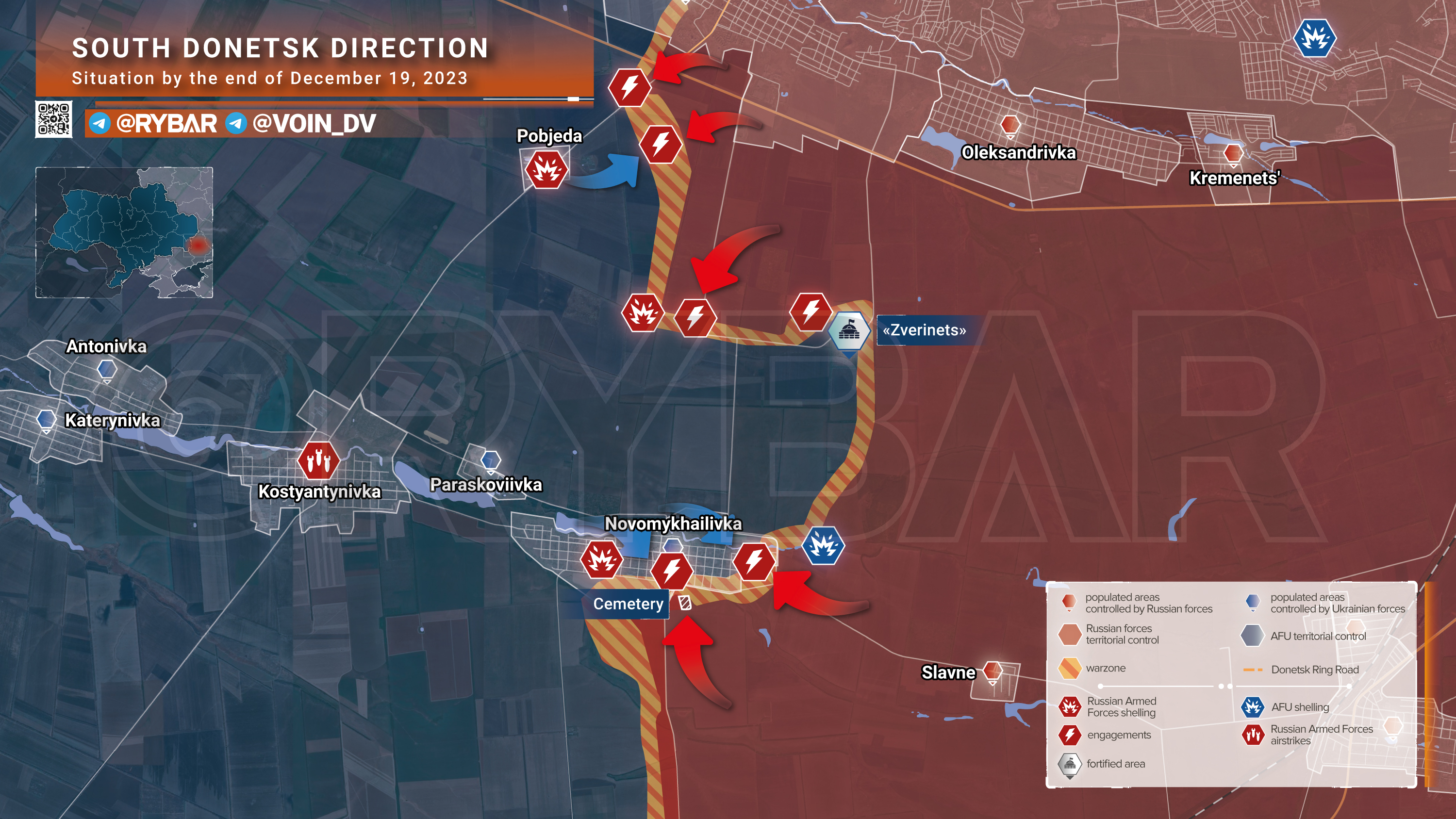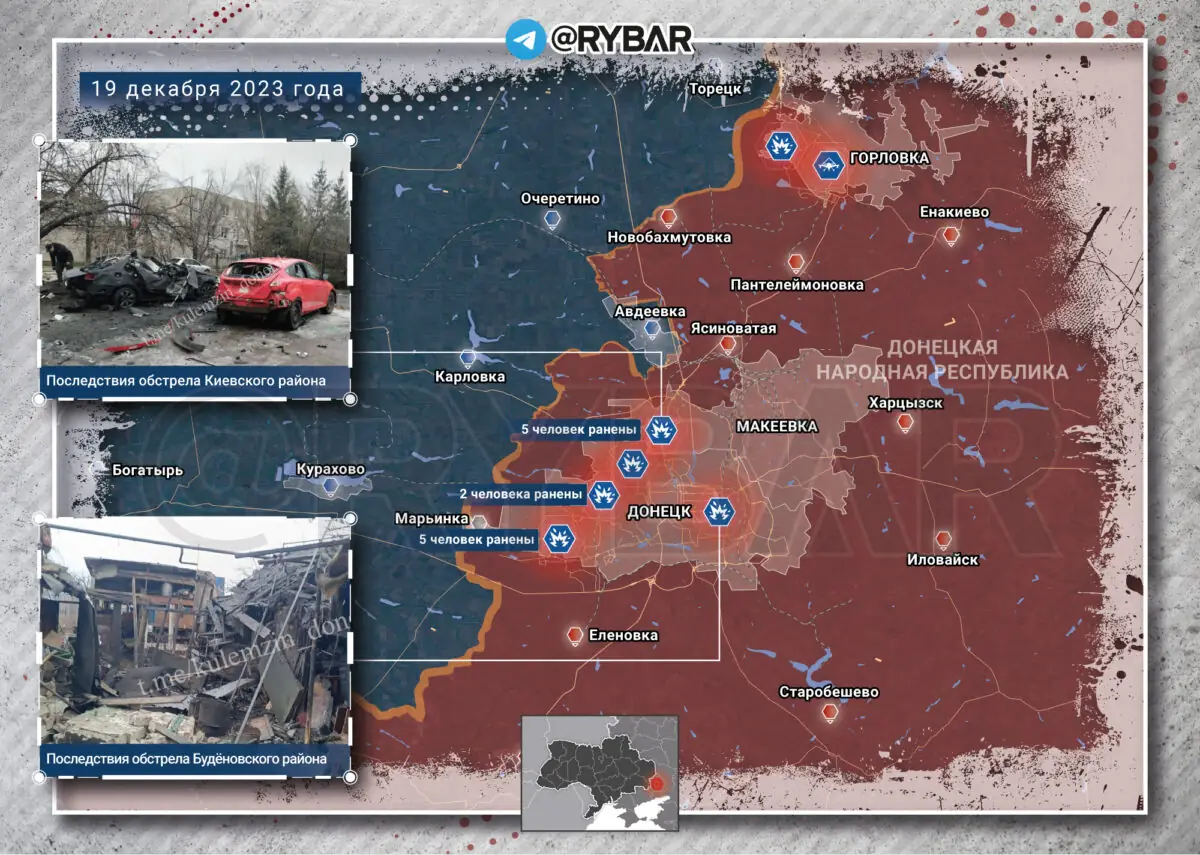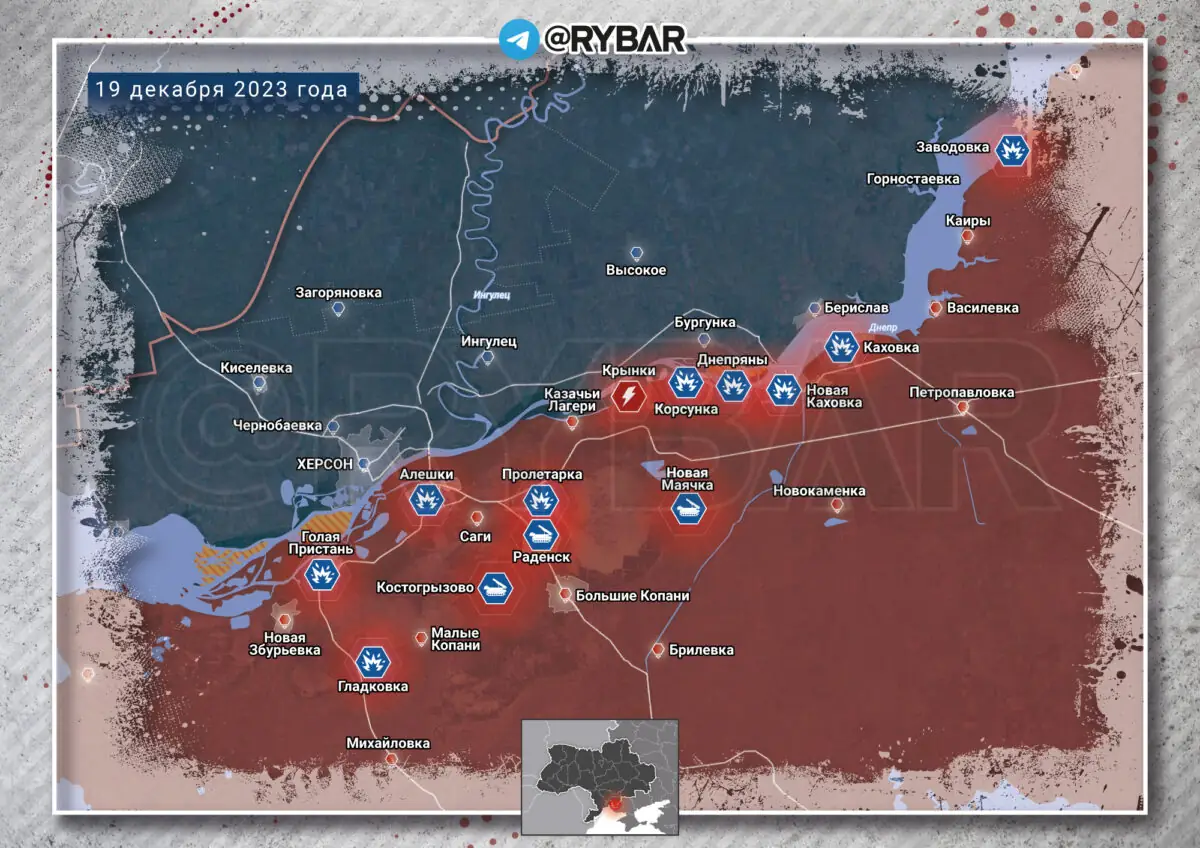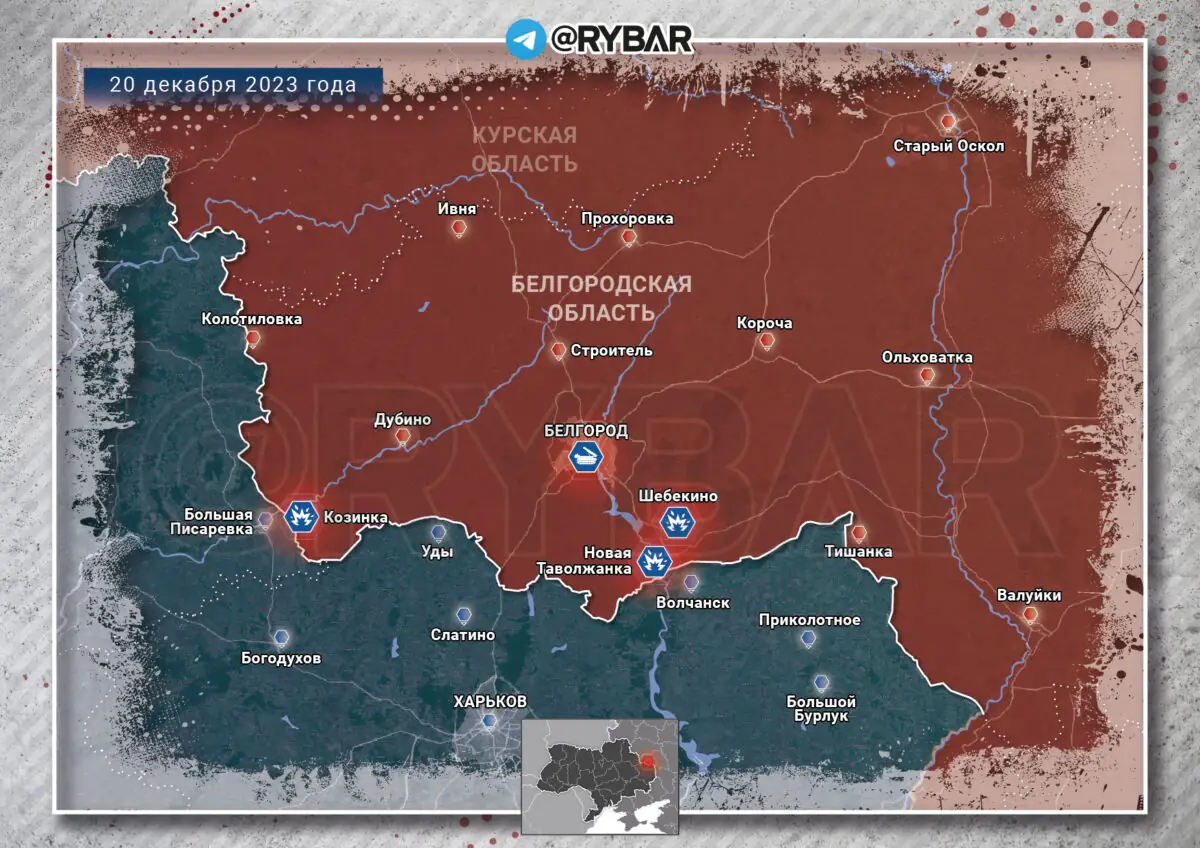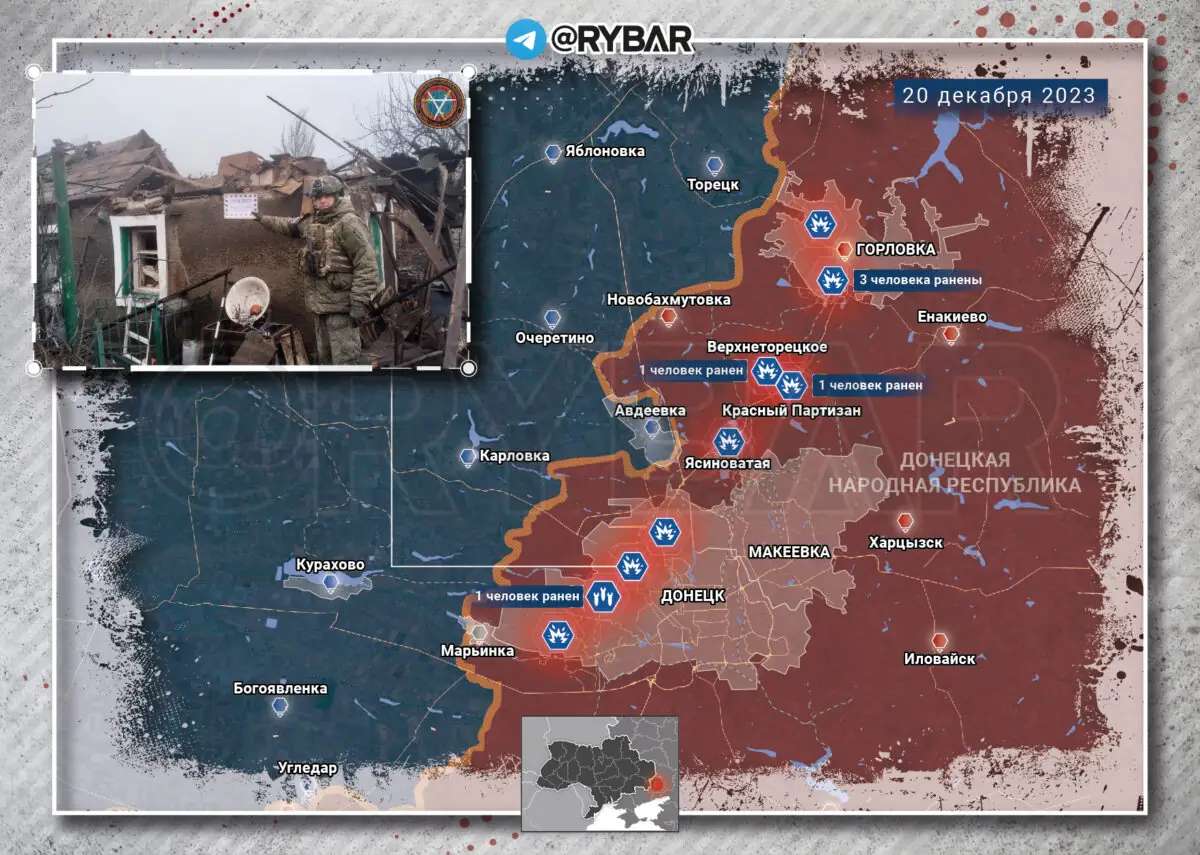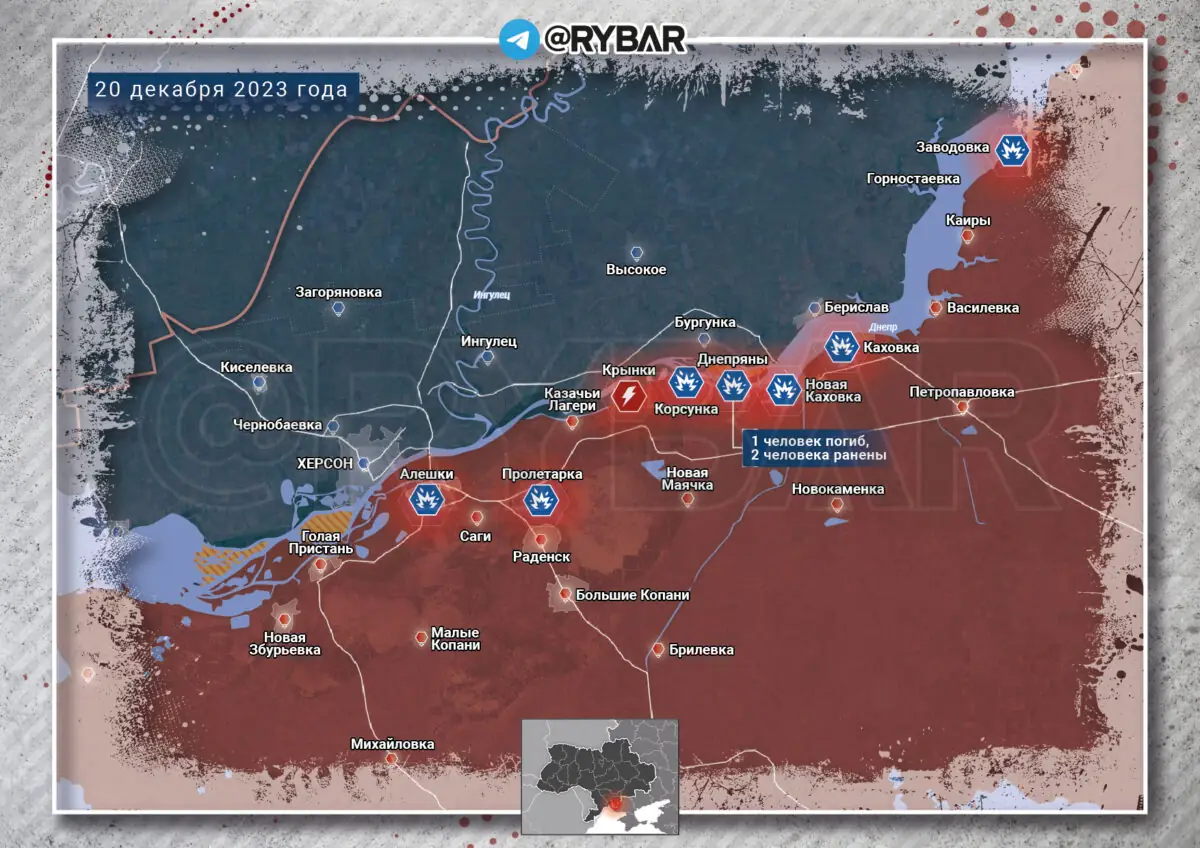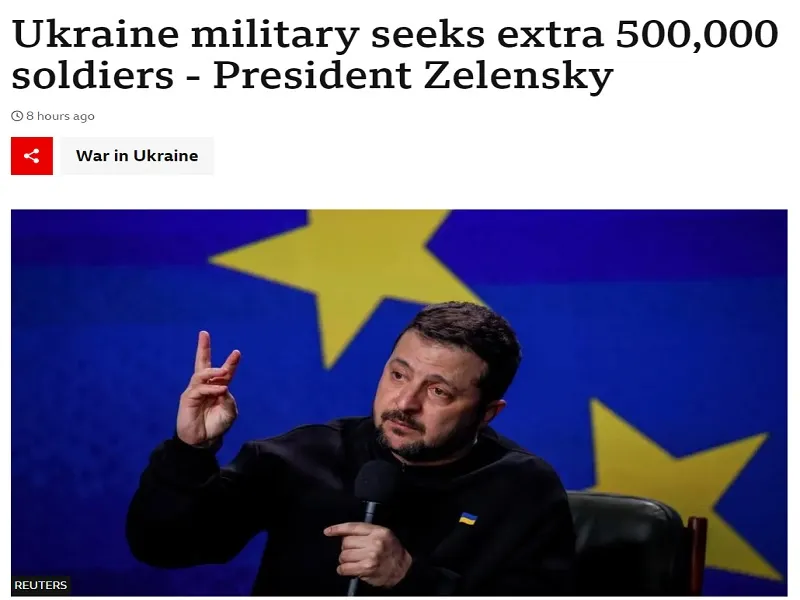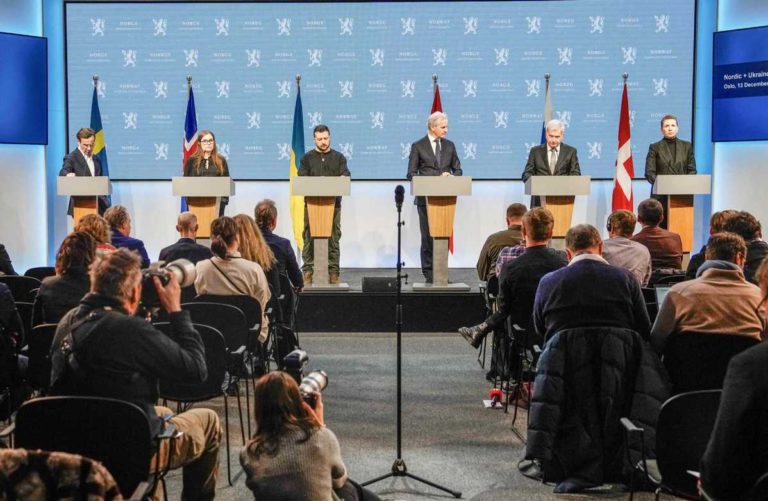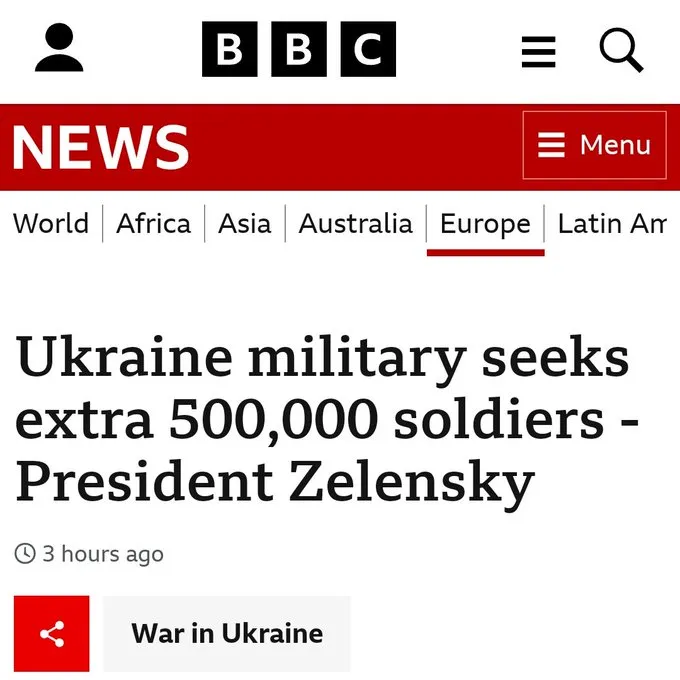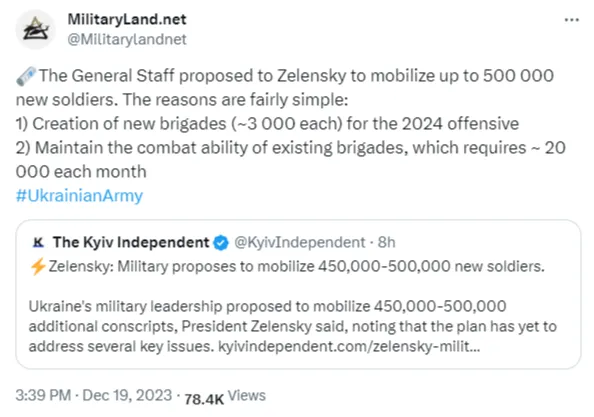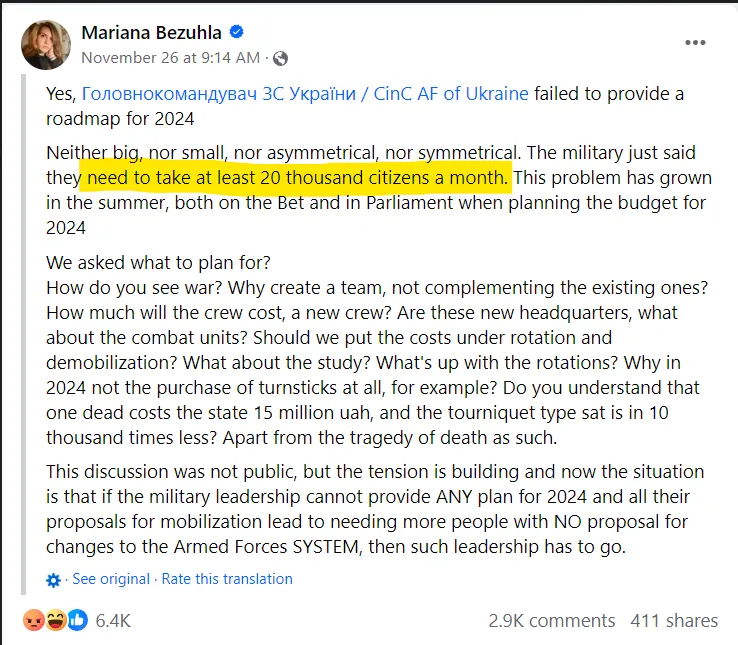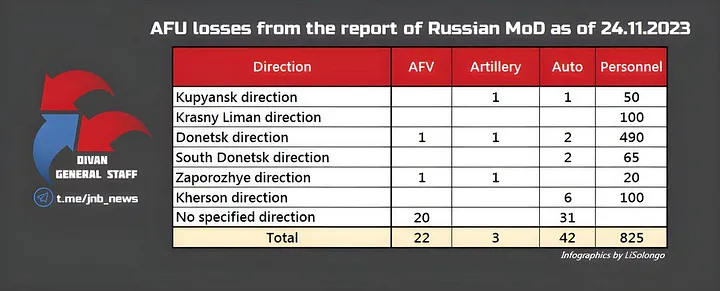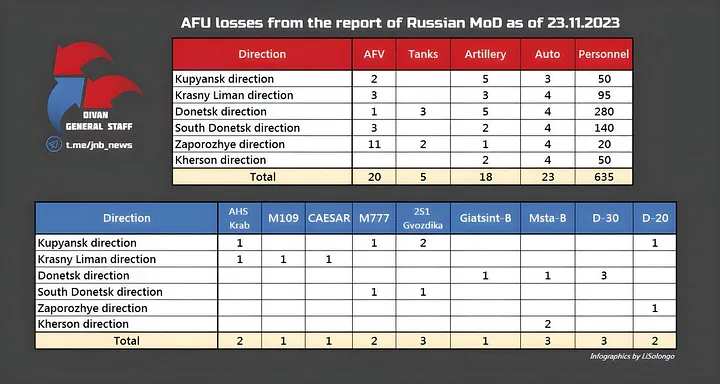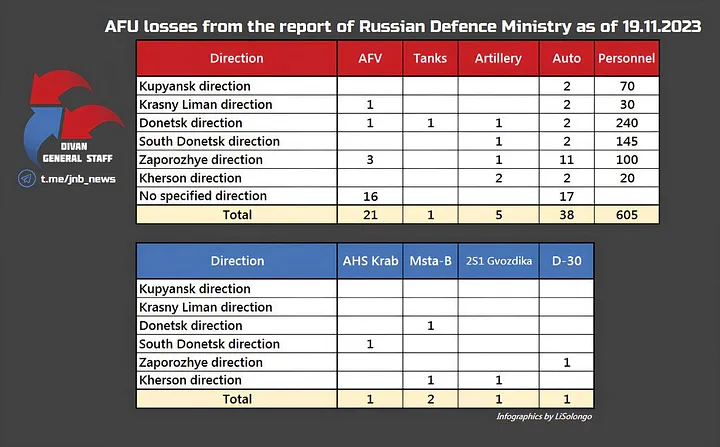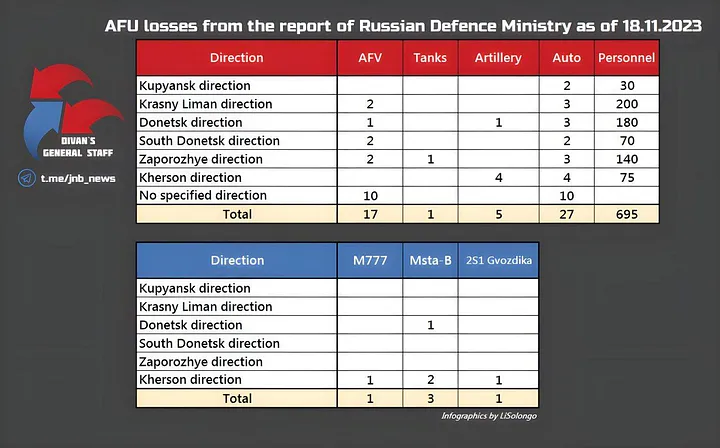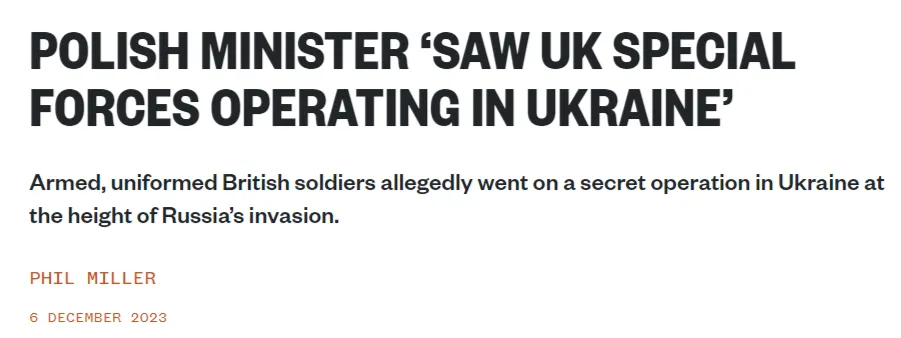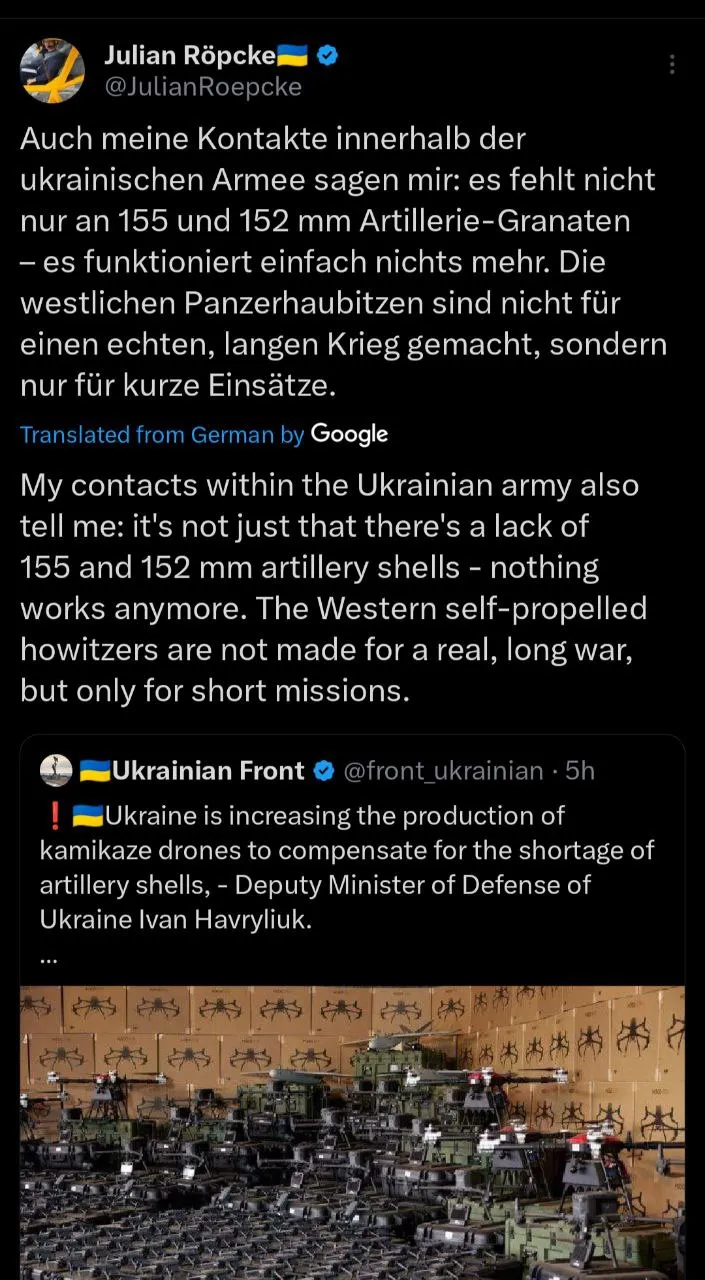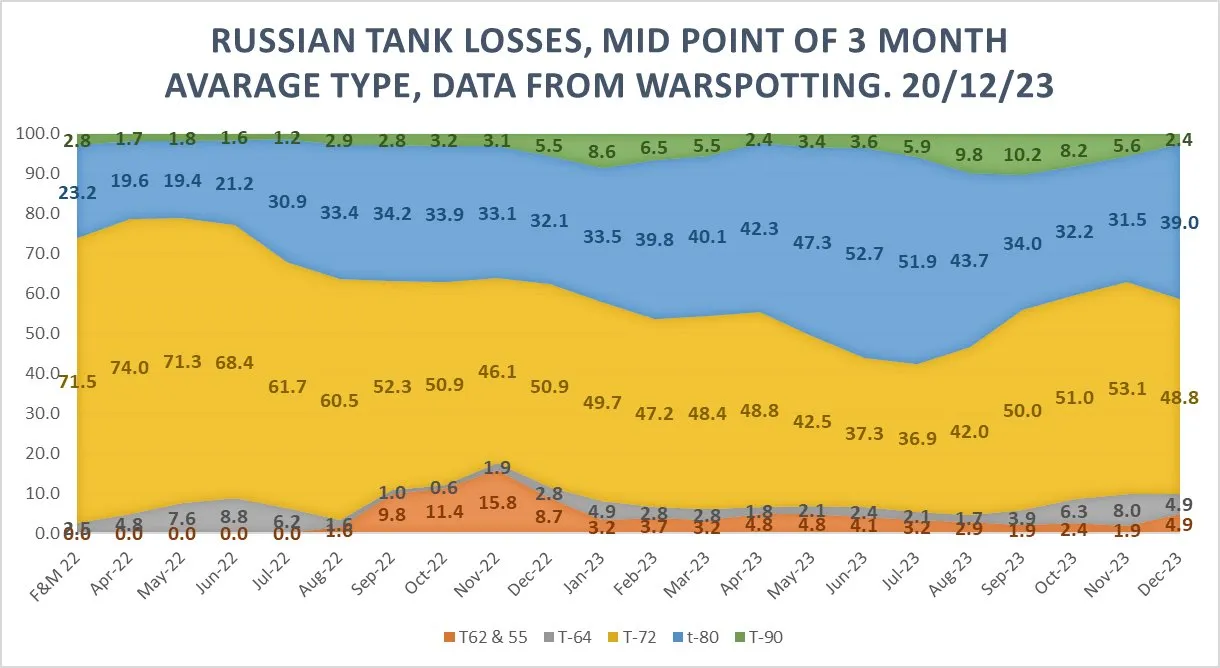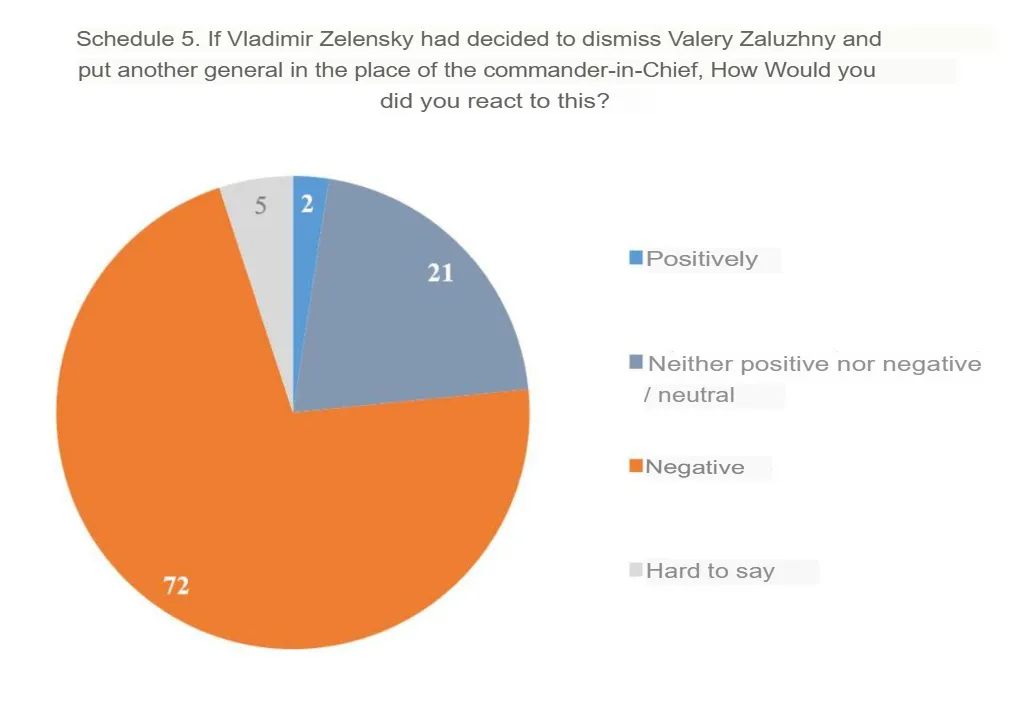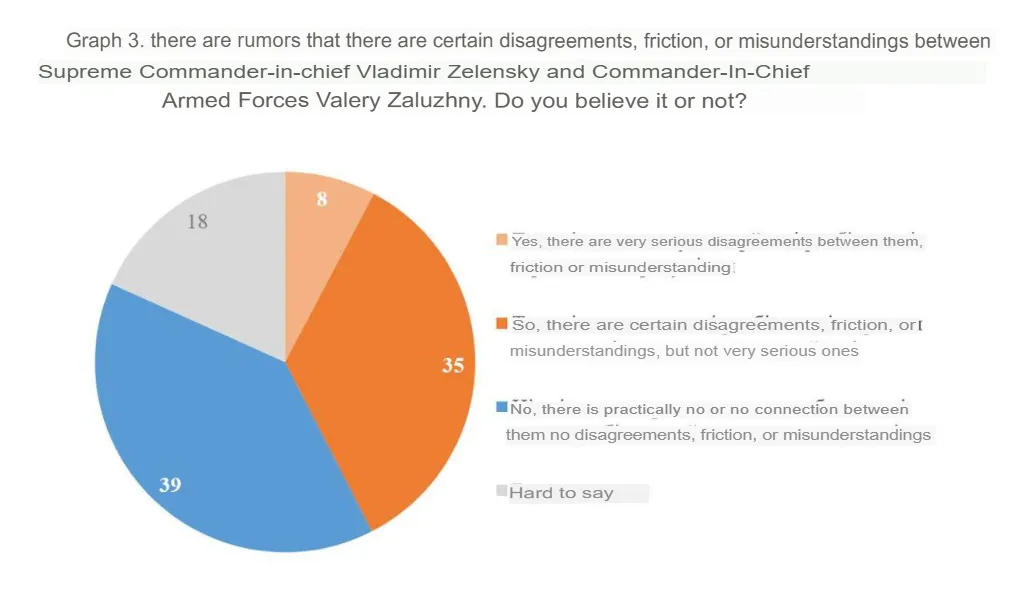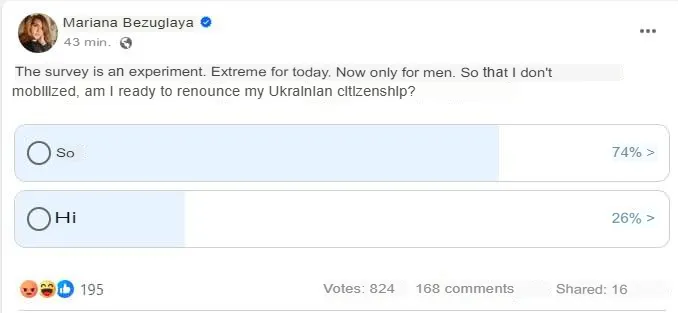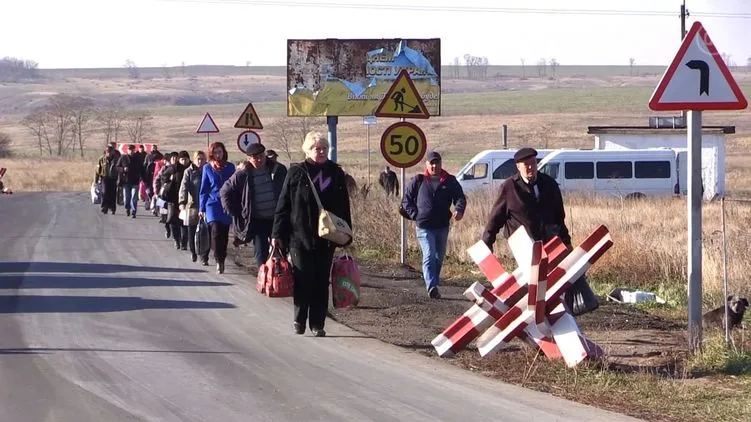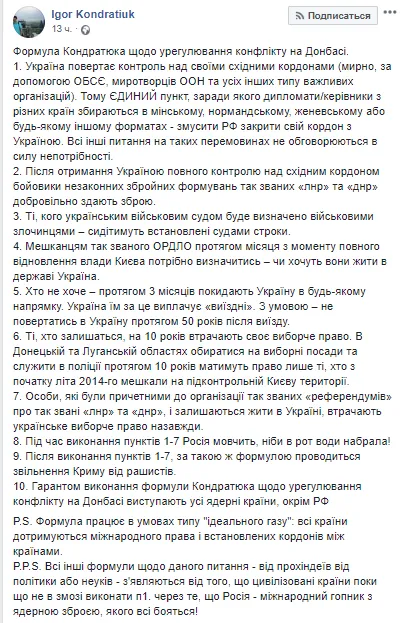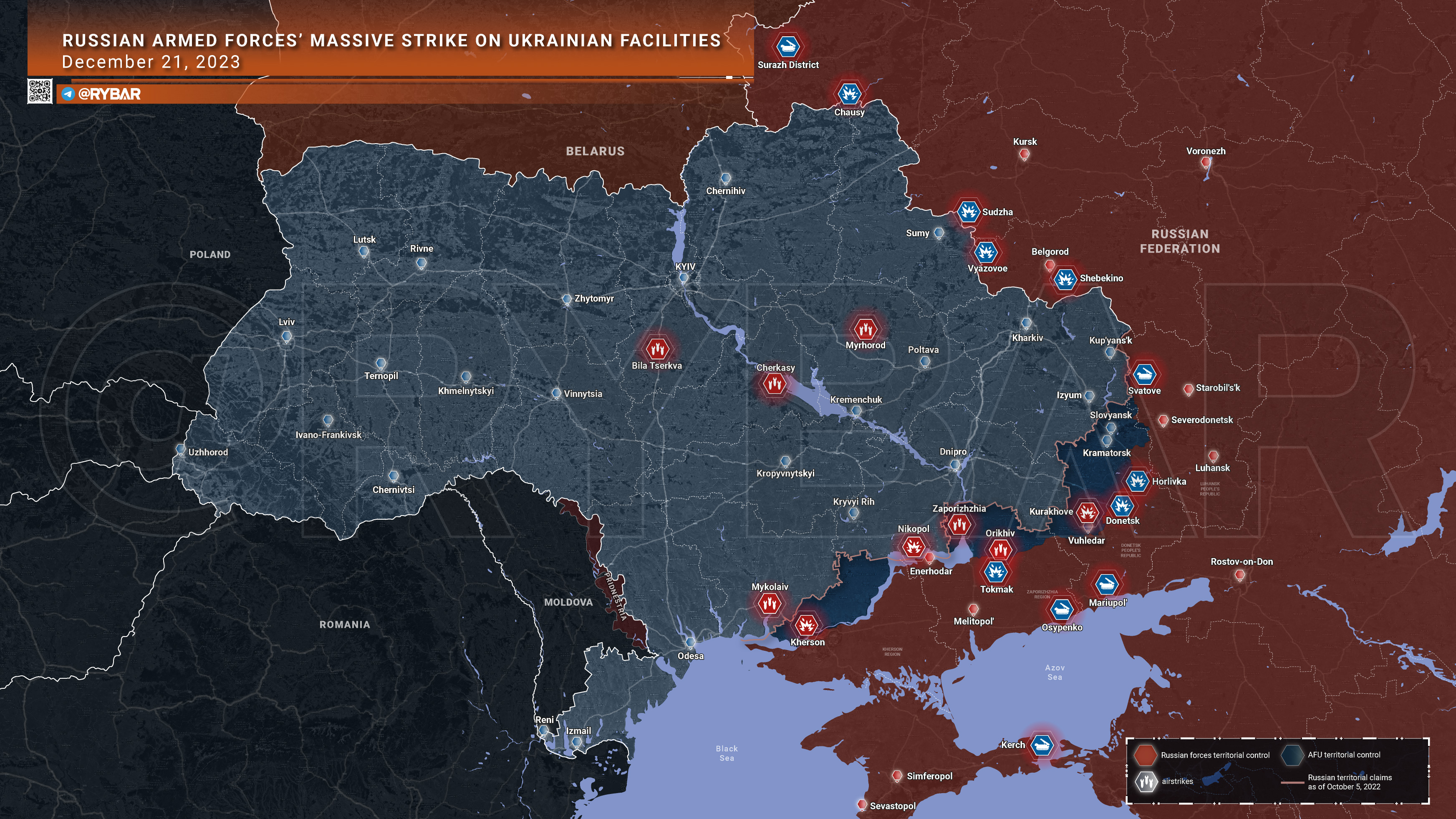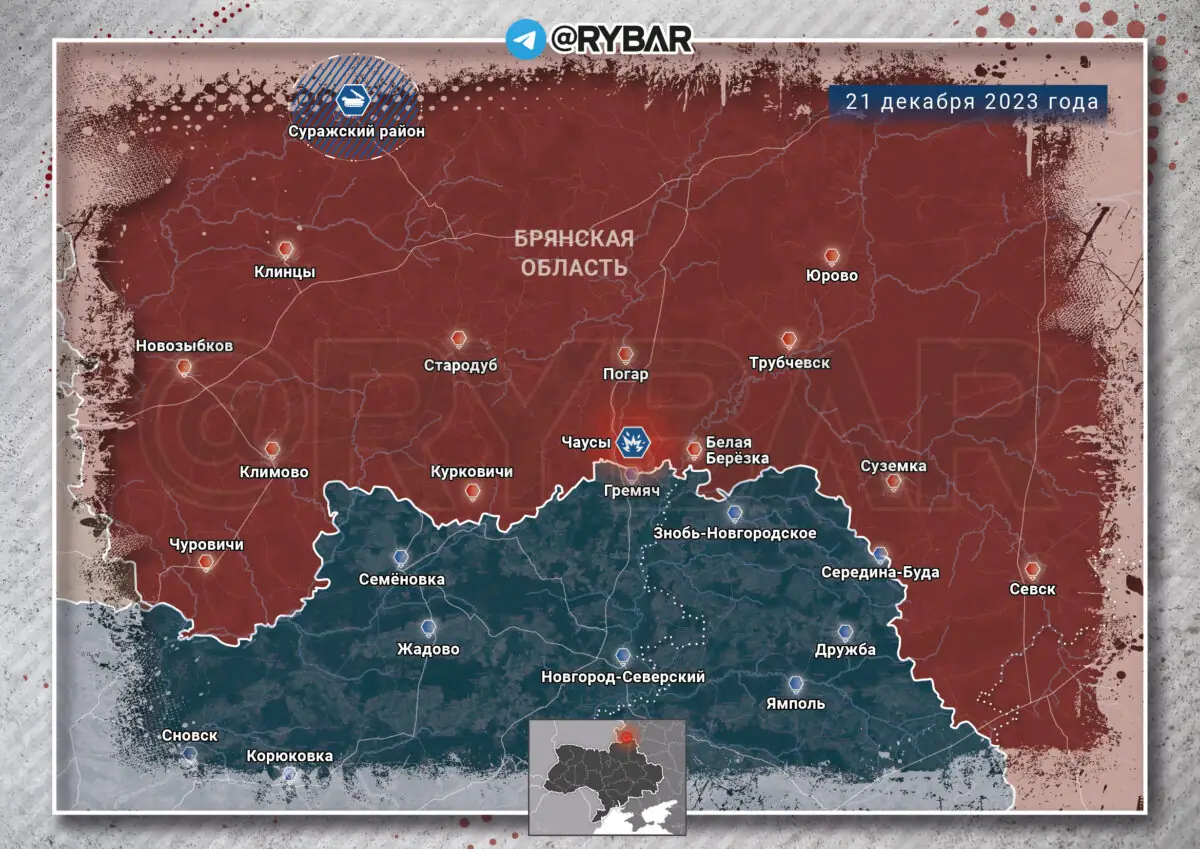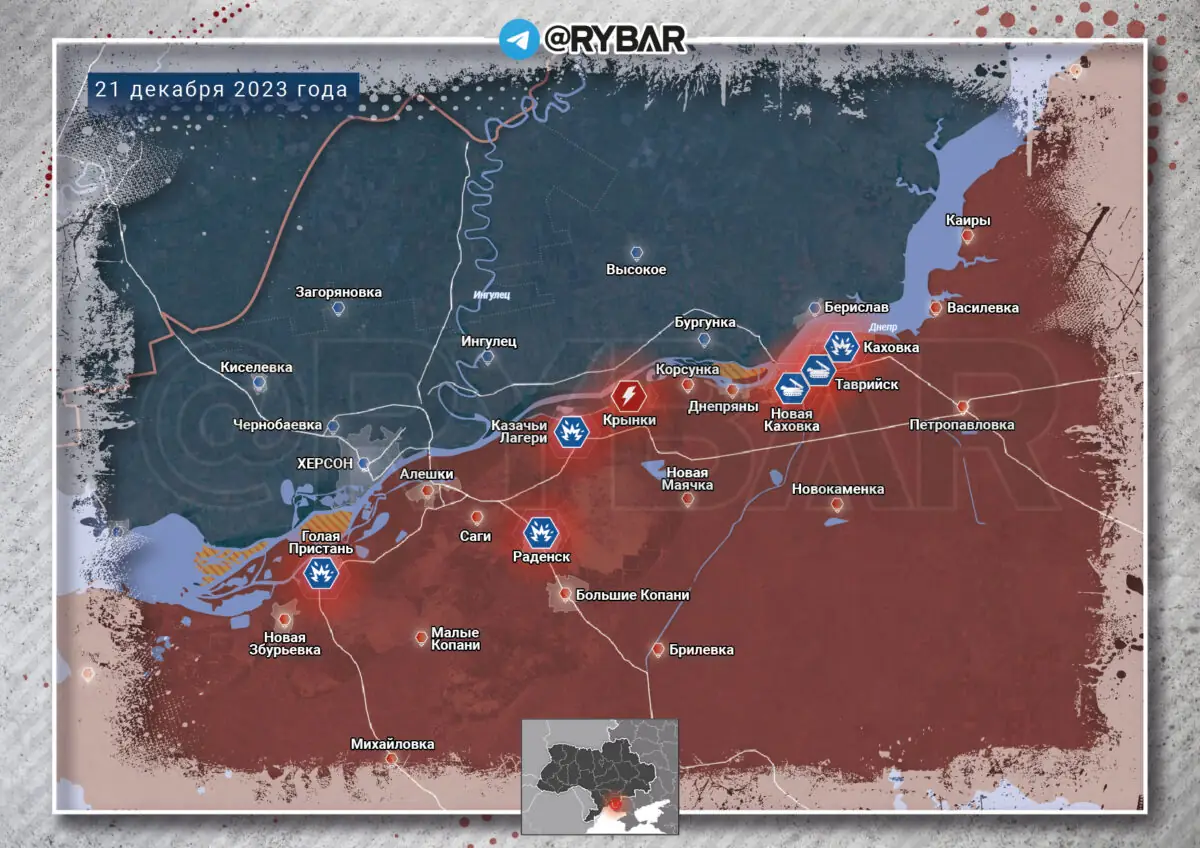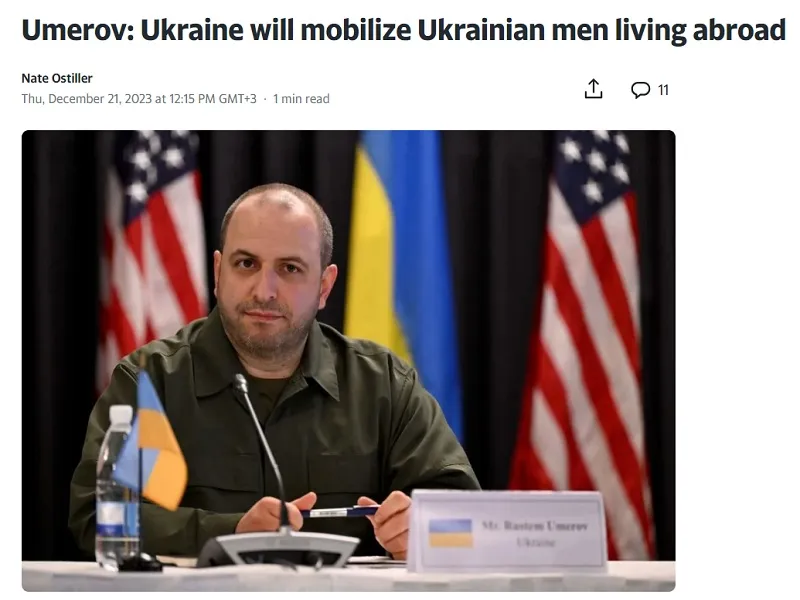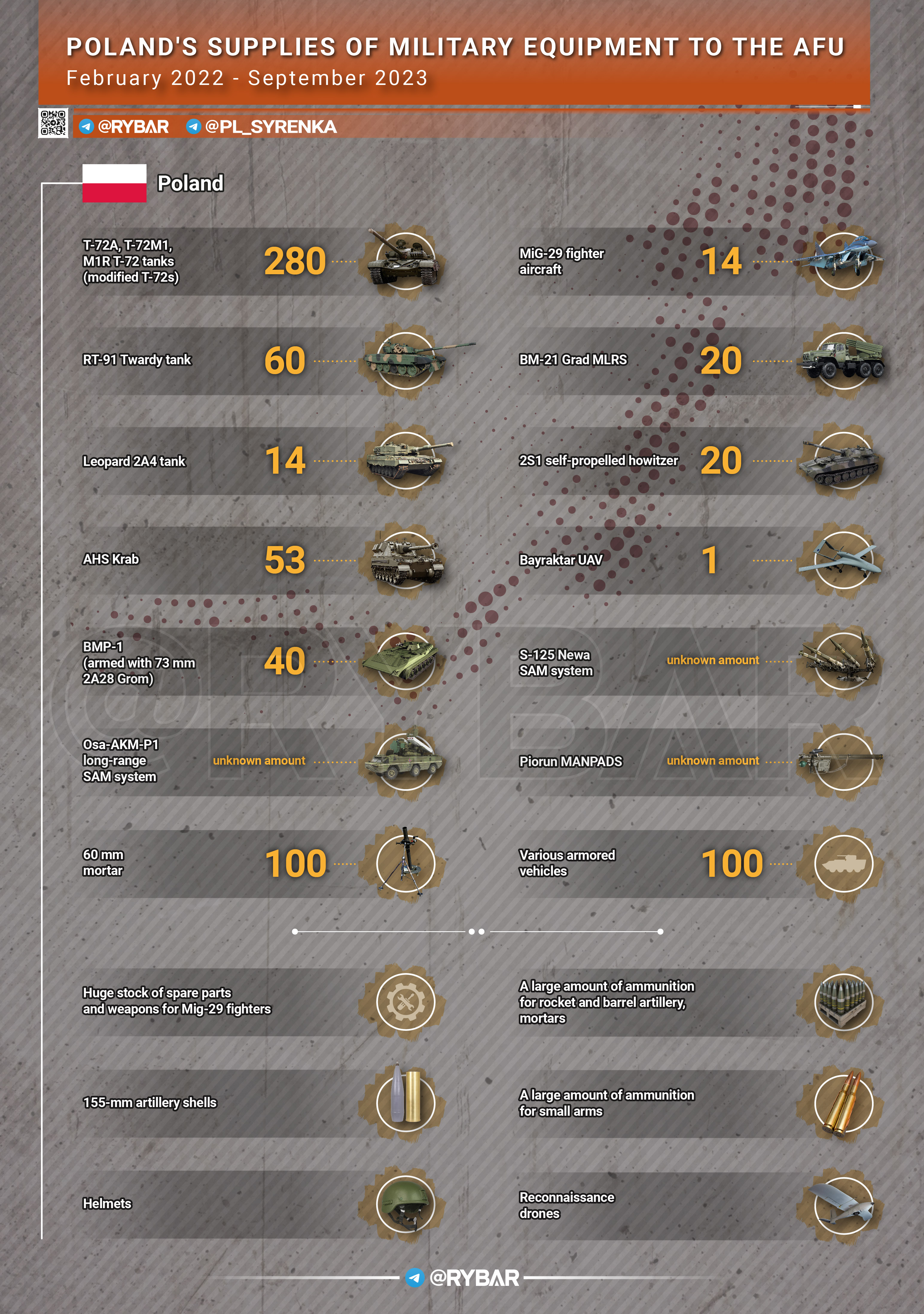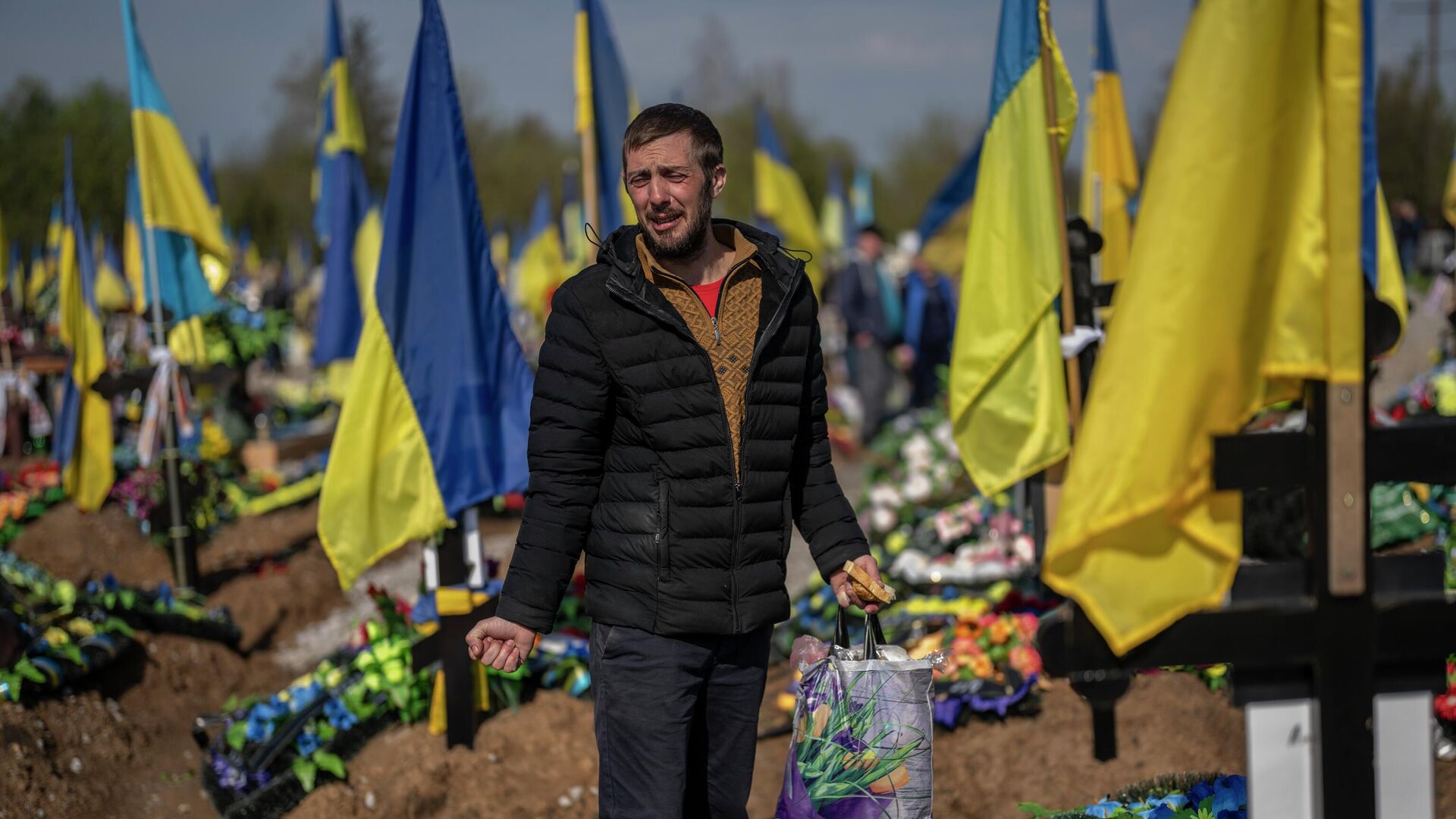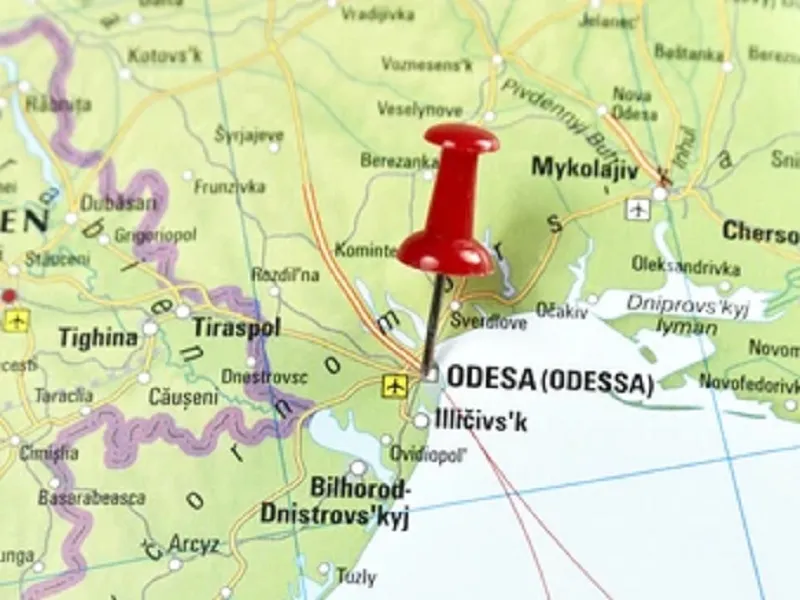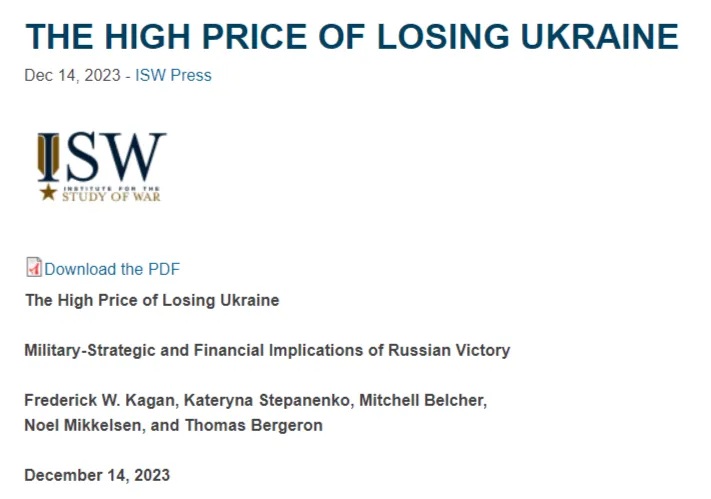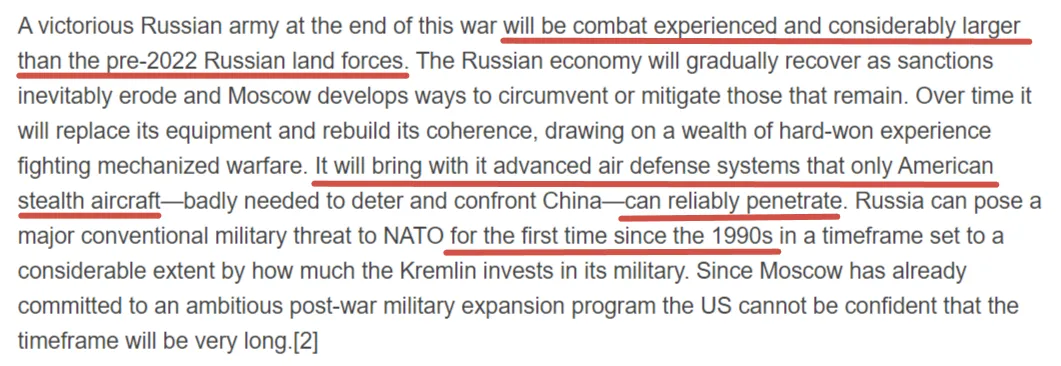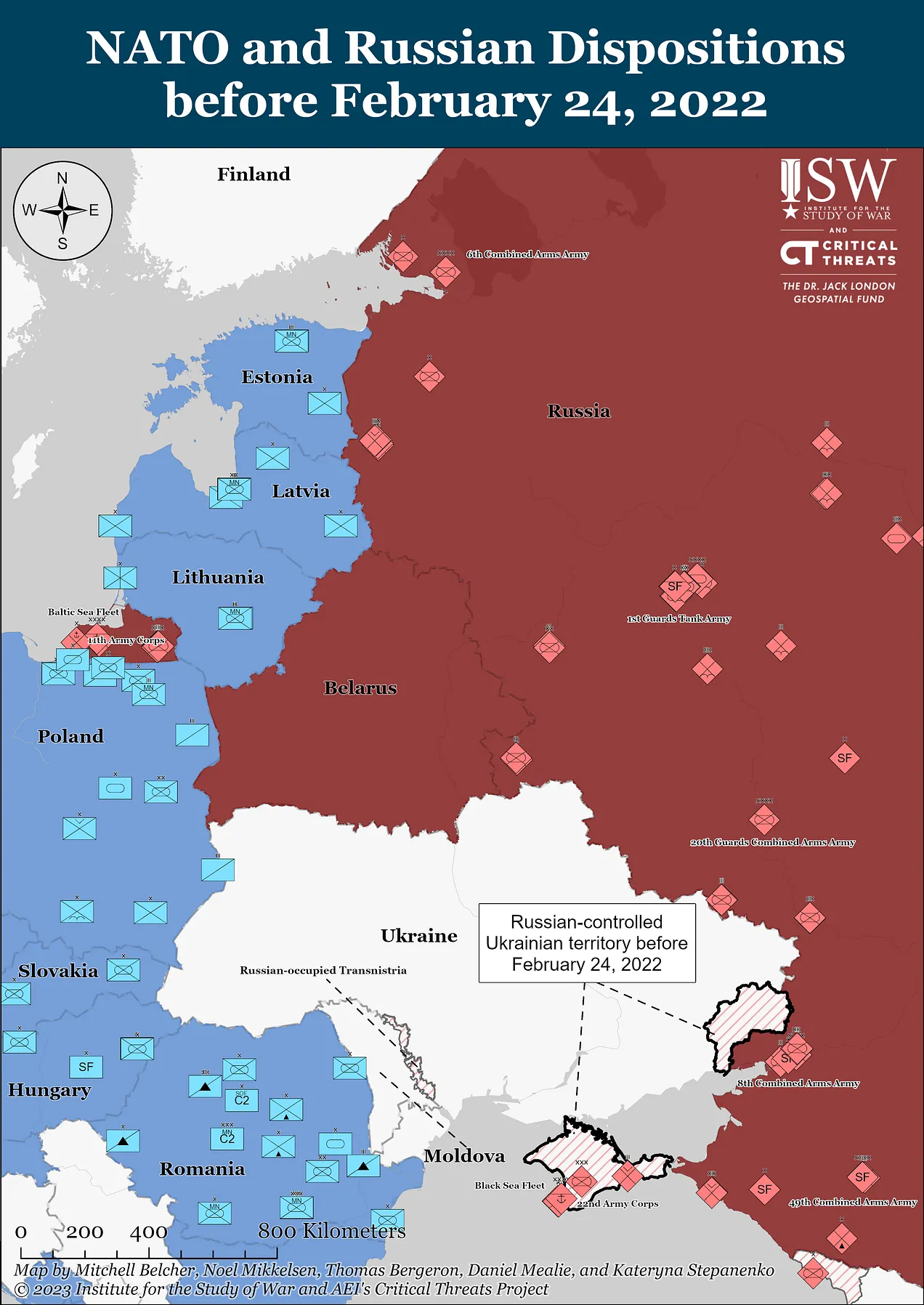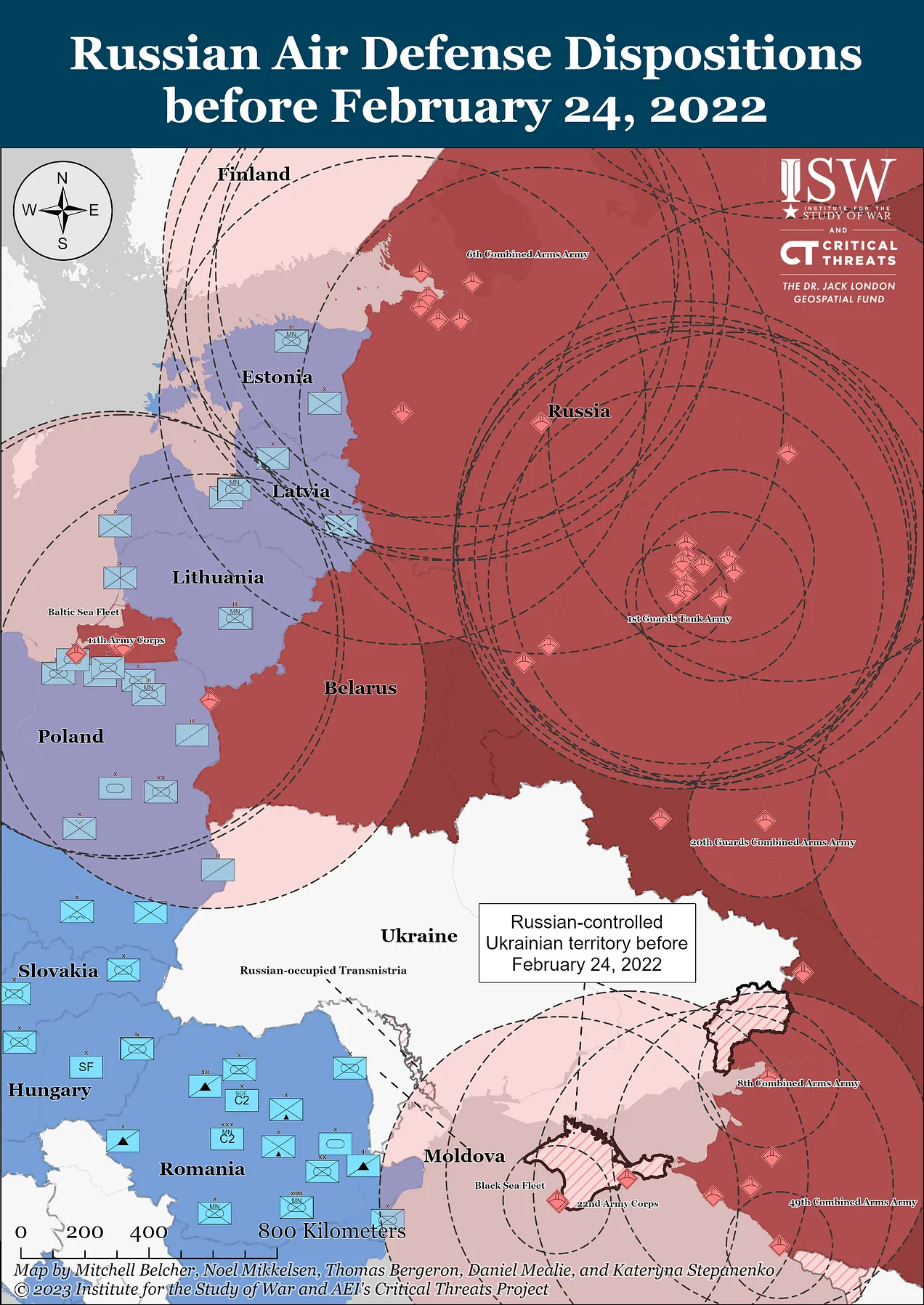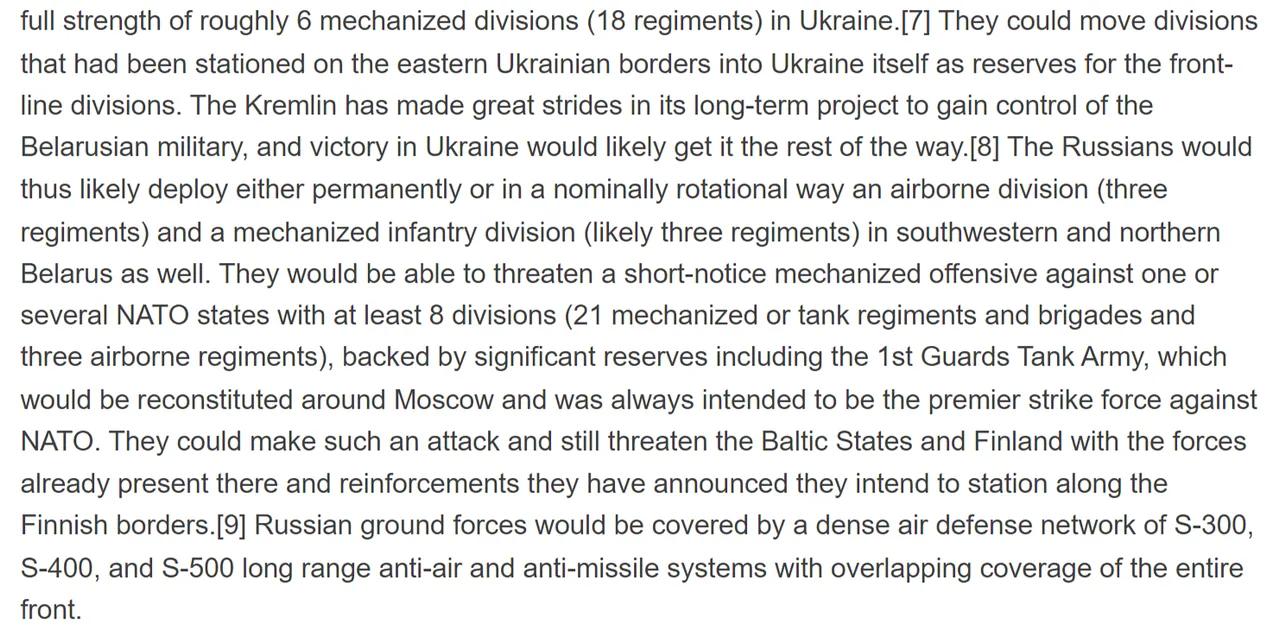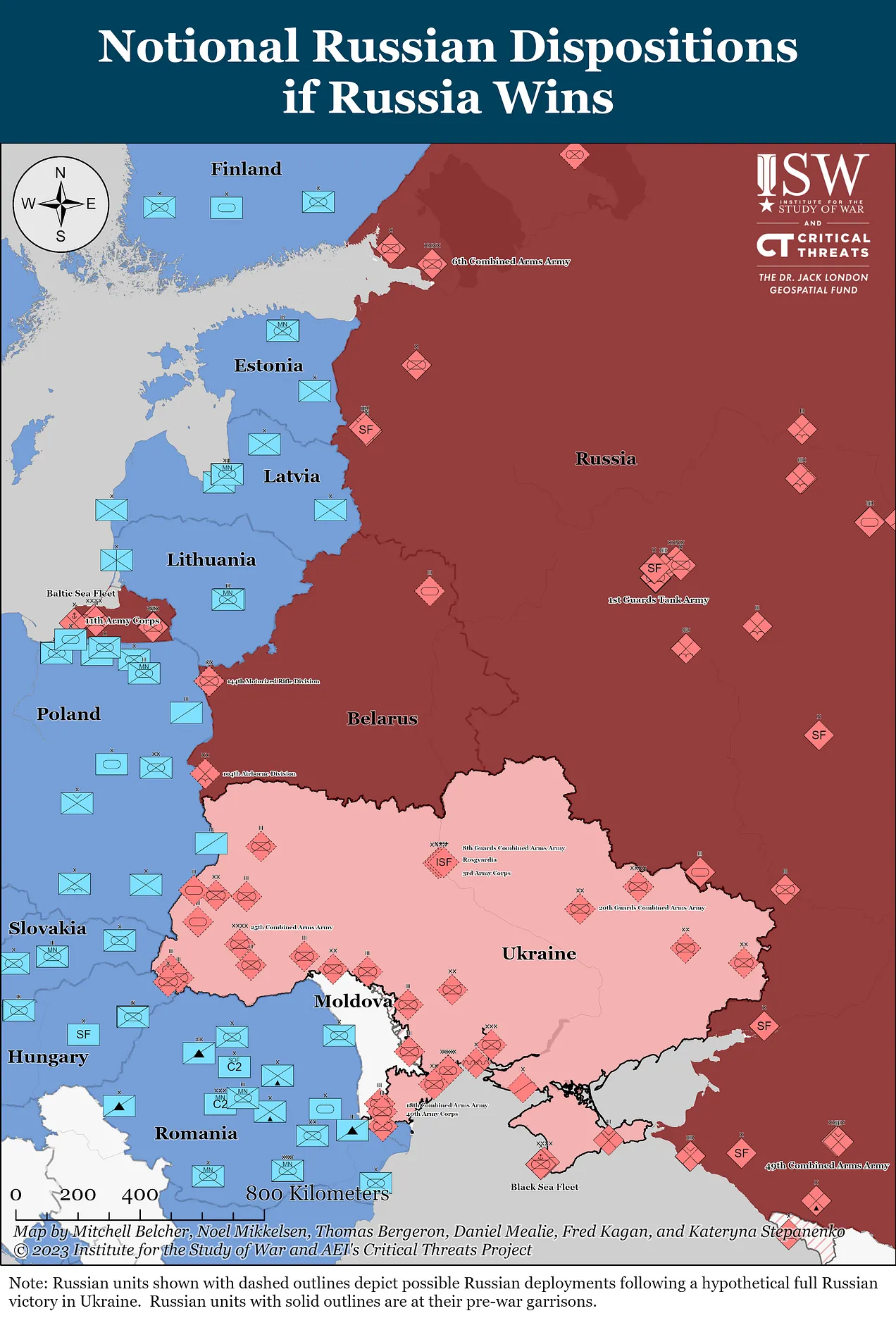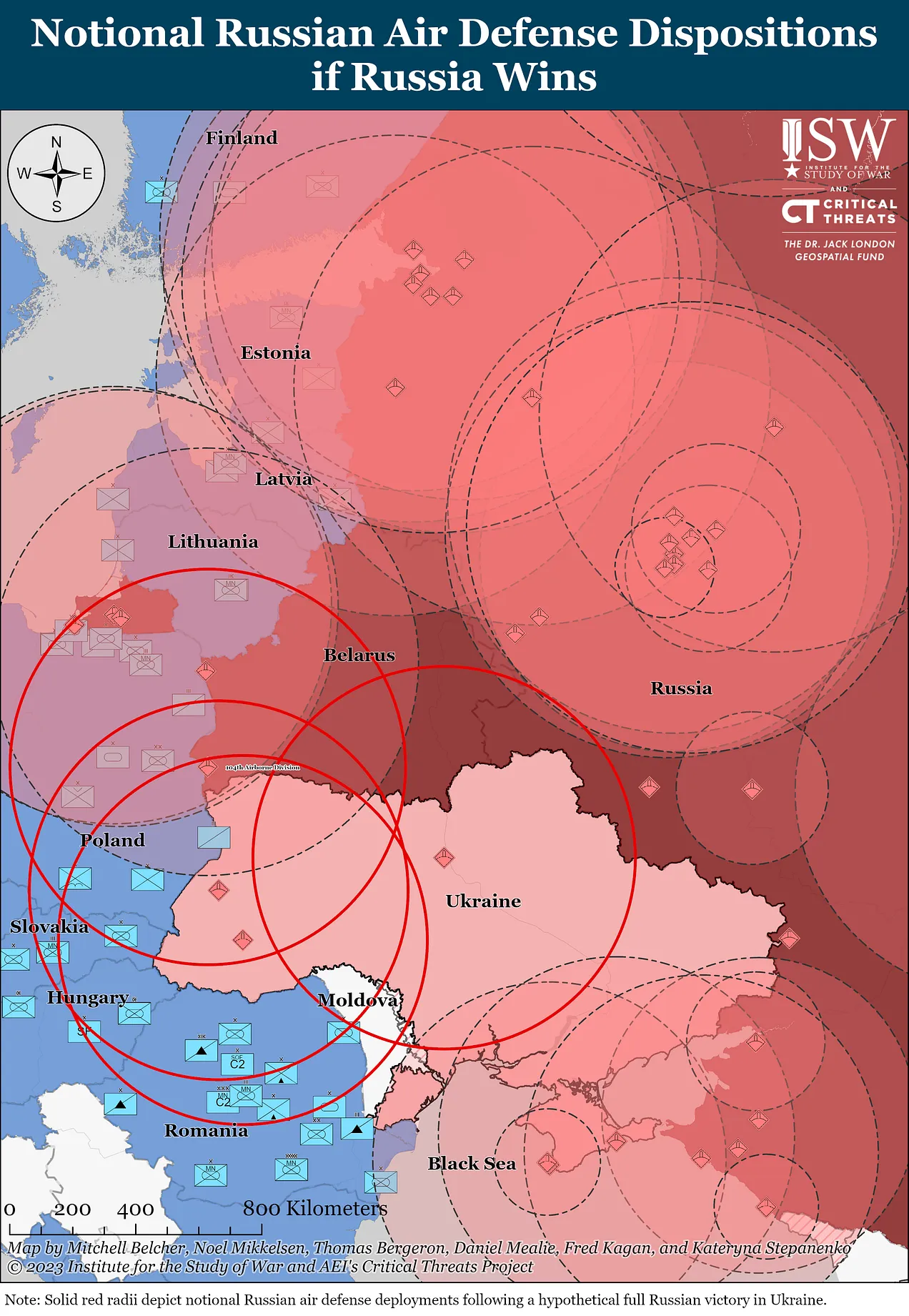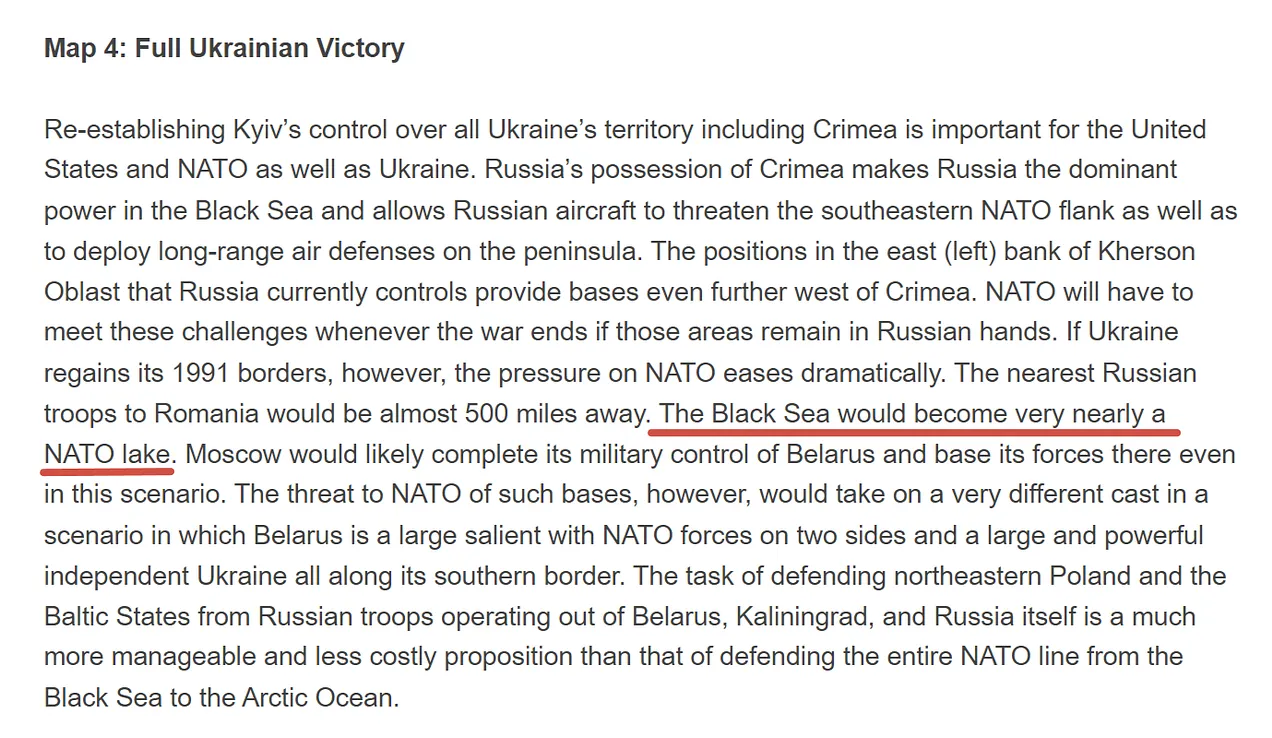POSTED BY @NSANZO ⋅ 12/19/2023

Numerical superiority has been, since the beginning of the Russian military intervention, one of the bases of Ukrainian tactics. Using their regular troops, the volunteer battalions (fundamentally formed by the most mobilized and ideologized groups in society, that is, those of the extreme right) and calling for volunteers at the national and international level, to whom they have subsequently joined not only volunteers but also mercenaries, Ukraine managed to contain the Russian attack on kyiv. This defense was carried out at the expense of the southern territories, where at least part of the troops withdrew without a fight, leaving the question of the level of collaboration with Russian troops up in the air. In any case, in all directions, the Ukrainian tactics of the first months were based on extending the front to the maximum to make it unmanageable for a Russian contingent that, possibly due to not having foreseen the level of resistance that was going to be encountered, was clearly insufficient to maintain all its positions and also try to carry out offensive actions in key areas.
The beginning of the war against Russia meant the arrival of foreign volunteers, but also a wave of volunteers at the national level, breaking the trend that had occurred in the Donbass war years of difficulties with recruitment, a recurring issue from the moment the Minsk process chronicled the state of war. The extension of the conflict to the entire country and the intensification of fighting far beyond what had occurred in the DPR and LPR increased the needs for mobilization, but the wave of nationalism compensated in the initial phases, when the allegations of forced recruitment that had been seen in previous years. The ban on men of military age from leaving the country forced those who did not want to fight to flee the country or go into hiding, but the increased influx of volunteers compensated for this chaos. As an article published these days by The New York Times points out, the state of exception that made the mobilization possible also caused a situation that lent itself to “interpretations.” subjective - and abuse - of recruitment laws.
“Everyone who wanted to come did so in the first six months,” Kirilo Budanov, leader of military intelligence, commented this weekend in reference to the need or not to maintain the general mobilization that Ukraine decreed in February 2022 and that is causing more and more headaches for Volodymyr Zelensky. There are already too many videos published on the Internet showing the forced recruitment carried out to replenish the ranks of the Armed Forces of Ukraine, which make the issue difficult for the Ukrainian Government to contain. And even the international press seems to have finally appreciated something that, although to a lesser extent and perhaps without such excessive use of force, has been happening for months, if not years.
“With the Ukrainian military facing rising casualties and battlefield stagnation, army recruiters have become increasingly aggressive in their efforts to replenish the ranks, in some cases removing men from the streets and taking them to recruitment centers using intimidation and even physical force,” The New York Times writes these days in an article that It collects testimonies from people who have been forcibly recruited into the army even though they theoretically believed they were exempt. The media reports, for example, the story of a 34-year-old store owner who believed he was safe from being mobilized due to a broken arm. His story is not unique nor limited to people with serious injuries, different types of disabilities or medical conditions, but rather extends to the entire population, whether or not they are the object of mobilization. The intensity of the war and the awareness that being sent to the front poses a high risk of death have led to an increase in lawsuits against these acts of forced mobilization. The American article mentions more than 200 cases in which justice has ruled in favor of the plaintiffs.
However, the images are excessive and graphic enough that they can no longer be ignored. “According to Ukrainian lawyers, activists and men who have been subjected to coercive tactics, recruiters have confiscated passports, removed people from their jobs and, in at least one case, attempted to send a mentally disabled person to training.” military. Videos of soldiers putting people in cars and holding them against their will in recruitment centers appear more and more frequently on social media and in local news,” the article adds.
“Without any explanation, without documents, without reason, an armed man got into my car and forced me to drive to the military recruitment center,” says Yefrimenko, the man whose broken arm has saved him, for the moment, from going to the forehead. Yefrimenko fled at night and is still fighting to be considered exempt from mobilization.
“While some believe the high number of casualties is partly to blame for aggressive recruitment tactics, others point to another reason: many Ukrainians have fled or avoided recruitment through bribes, leaving one group each dwindling number of recruits, some of whom are theoretically exempt from mobilization,” explains The New York Times to downplay the idea that Ukraine is suffering casualties greater than the replacement it is capable of guaranteeing.
Everything would be simpler if Ukraine still had the regional military commissars that Zelensky dismissed en masse. That's what Valery Zaluzhny thinks, at least, who yesterday left another episode in the already long list of differences of opinion between the military and political authorities. “They were professionals, they knew how to do it, but now they are gone,” he declared. All parties agree, however, on the need to continue aggressive recruitment. “It is impossible to avoid mobilization,” Budanov explained, adding that “there are currently 1.1 million people in the Armed Forces of Ukraine. There is no recruitment [of volunteers] that can cover those volumes.”
Casualties are piling up, the chronification of the war and the decline of the initial wave of patriotism in the face of the reality of battle makes recruitment difficult at a time when Ukraine cannot afford to reduce personnel levels. Given this, kyiv has three options: continue as before, with forced recruitment that will continue to leave striking images of soldiers hunting recruits after work or at the supermarket; recover the previous system as Zaluzhny suggests or, privatize the system and leave it in the hands of human resources companies. That seems to be the instinct of Volodymyr Zelensky, for whom privatization is always the first option.
https://slavyangrad.es/2023/12/19/probl ... amiento-2/
Google Translator
(Edited for redundancy.)
*****
What's happening in the Northeast Military District zone: chronicle for December 18
December 18, 2023
Rybar
In Soledar direction The Russian Armed Forces are conducting an active offensive along the entire front line. On the northern flank, Russian troops are trying to advance to Krasny, as well as to establish control over the route to Chasov Yar . Meanwhile, south of Bakhmut units of the Russian Armed Forces are conducting attacks at the Kleshcheevka line —Andreevka.
In Avdiivka sector Ukrainian formations are also in a difficult situation. So far, the enemy is having difficulty holding positions on the northern flank near Stepovoyand Petrovsky, but in the south, Russian troops, after a lengthy artillery barrage, were able to advance in several sectors.
Russian troops continue to strike enemy targets in the rear regions of the so-called. Ukraine. Explosions were reported inDnepropetrovsk, Starokonstantinov, Krivoy Rog, Kherson, as well as in the city Kremenchug< /span>. Nevertheless, Ukrainian censorship has so far managed to prevent the emergence of information about the targets hit.
On the intensity of Ukrainian Armed Forces strikes on Russian territories
After a long break, the Armed Forces of Ukraineresumed attacks on the rear regions of Russia. In the second half of the week, the enemy made an unsuccessful attempt to raid Crimea. At the same time, similar attacks were repulsed in other regions of the Russian Federation. Given the long pause, the enemy could have accumulated a sufficient number of weapons for new attacks on the eve of the New Year.
On the night of December 14, electronic warfare and air defense systems shot down drones in the Kaluga and Moscow regions. The enemy's targets were military and infrastructure facilities of the Russian Federation.Volgograd regionsand, Rostovskaya, and already at the end of the week Ukrainian formations tried to strike at
In parallel with this, in Kursk region air defense crews shot down six missiles. There was also unrest in the neighboring Belgorod region, where a shootout took place near the village of Terebreno. In just one week, more than300arrivals were recorded in the border regions, sixsixcivilians.
At the same time, regular shelling of populated areas of Donetsk People's Republic continued, on which about 500 were fired civilian died.and one 12: the peak of shelling was on December 13-14, when damage was caused in two daysDonetskshells. As before, most of the attacks took place in the western regions of
No less damage was caused to Kherson region, in the cities and villages of which over 400 400 arrived a>, and in another - he fired at a humanitarian warehouse in Novaya Mayachka from the HIMARS MLRS.Radensk- Alyoshkiwere injured. During one of the attacks, the enemy struck an ambulance on the highway ninepeople killed, anotherfive ammunition:
The situation on the front line and combat operations

On the night of December 17-18, the Russian Armed Forces undertook a hitch attack on Ukrainian targets in Dnepropetrovsk, as well as in Starokonstantinov. In addition, in the afternoon, Ukrainian resources reported explosions inKrivoy Rog, Kherson, as well as in the city Kremenchug. It is characteristic of the latest explosions that no air raid warnings were issued. At the same time, in Kremenchug, representatives of local authorities reported “claps” at one of the industrial facilities.
On Starobelsky direction the situation has not undergone significant changes: the parties are conducting positional battles and artillery duels. Russian troops are attempting attacks in the area ofTorsky ledge and Serebryansky forestry, however so far the RF Armed Forces have not been able to visibly change the configuration of the front.

In the Soledar direction Russian troops continue to advance along the entire line of contact. On the northern flank, the main battles are taking place on the approaches toKrasnoe: units of the Russian Armed Forces are clearing the dachas, after which the path in the direction of the treasured settlement will be open. At the same time, near Khromovo, Russian military personnel are carrying out attacks towards the highway to Chasov Yar. 8>. Clashes continue to the north-west ofBakhmut, including in the areaOrekhovo–Vasilevki and Bogdanovka. On the southern flank, Russian troops are trying to regain control of the dams near the railway line in the Andreevka area. At the same time, the RF Armed Forces continue to hold the dominant height 215.7 on the northwestern outskirts of Kleshcheevka, from where they control the advance routes of the Armed Forces of Ukraine to the village.

In Avdeevsky sector The Russian Armed Forces are pushing through the enemy defenses on the flanks. Significant success was achieved on the southern flank. Previously, active artillery preparation was carried out in this area for several days before offensive operations. Now Russian troops are advancing in the direction Northern - Tonenkoe, and are also conducting fighting to the west in the areaNetailovo. On the northern flank, fighting continued in the area of the forest belt near Stepovoye, as well as near Petrovsky. In addition, there were battles for the private sector to the west of the previously liberated industrial zone.
In Orekhovsky sector there were no significant changes in the front line. Nevertheless, battles continued for the plantings north of Verbovoy. The parties exchanged artillery strikes, and the aviation of the Russian Armed Forces was actively working.
In Kherson direction the main problem for the Russian group remains Ukrainian UAVs and enemy long-range artillery on the right bank. There is still a lack of comprehensive counter-battery warfare, although some progress has been made in this area in recent months. Despite this, the garrison of the Ukrainian Armed Forces in Krynki is also having a hard time: the sanitary situation is deteriorating, the enemy is increasingly sending boats overloaded with personnel and cargo, which become easy targets for UAVs and artillery. To all this it is worth adding the fact that the Russian Armed Forces regularly strike Ukrainian air defense forces and infrastructure facilities on the right bank of the Dnieper.
Shelling of rear areas and residential areas

In Bryansk region AFU shelled the village Sopychi Pogarsky district . Local authorities reported damage to one home as well as a vehicle. There were no injuries.
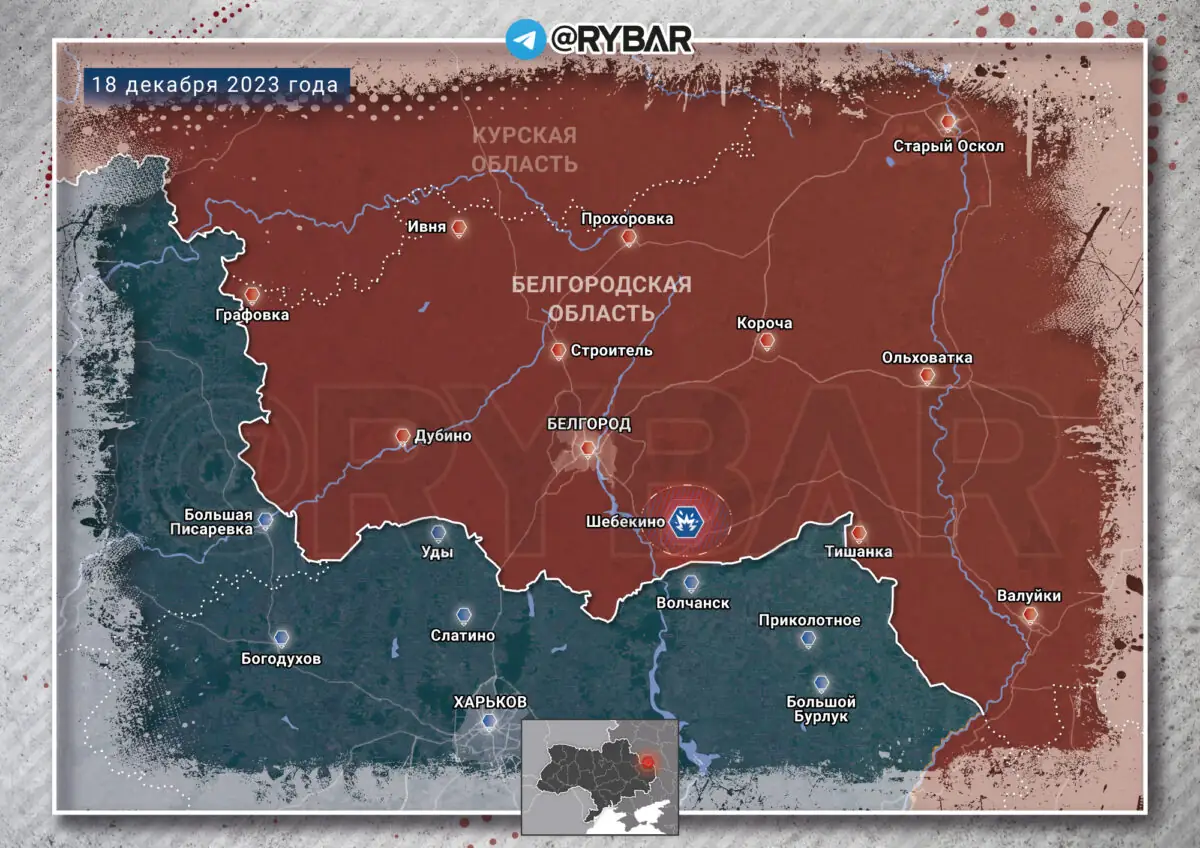
In Belgorod region arrivals were recorded in Shebekinsky urban district. There were no reports of casualties or damage. At the same time, Russian artillerymen carried out retaliatory strikes on enemy firing points.

It was relatively calm in the Donetsk People's Republic. ThePetrovsky district Donetsk was shelled several times, and the enemy twice dropped military equipment from a drone in < a i=6>Kirovsky district of the city. In addition, the Russian Ministry of Defense reported on the work of air defense in Gorlovka. According to preliminary information, there are no casualties.
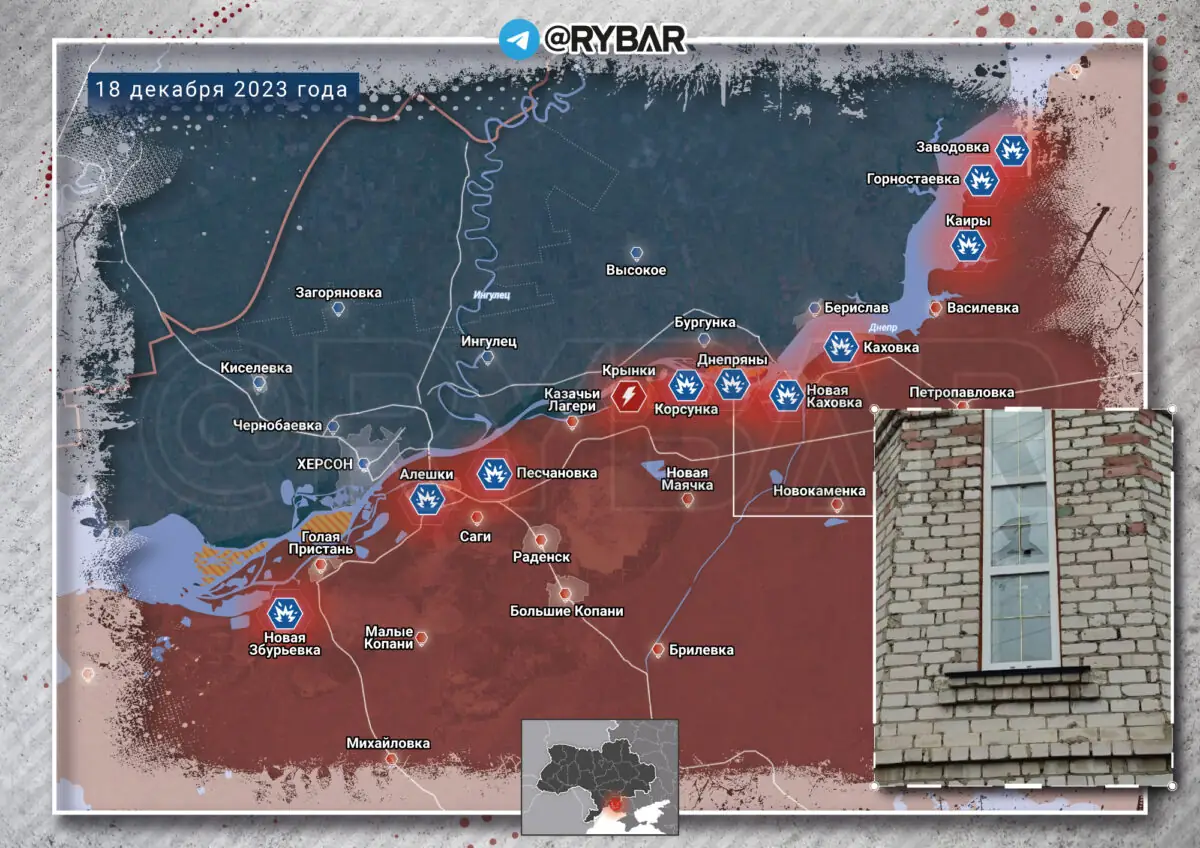
Ukrainian formations continued to strike on the left bank of the Kherson region. For several weeks now, there has been an increased concentration of enemy drones in this direction, which affects not only military personnel of the Russian Armed Forces, but also civilians. Today the following were under fire: Novaya Kakhovka, Kakhovka, Peschanivka, Korsunka, Aleshki , Dnepryan, Krynki and New Zburevka. Also, during the day, 25 impacts were recorded inGornostaevsky district.
Political events
About another result of the “counter-offensive”
Officials of the so-called Ukraine is increasingly talking publicly about a possible abandonment of offensive actions this winter if Western military assistance decreases and talk about the start of construction of three lines of defense. The nuance is that even if supply volumes remain unchanged, the Ukrainian Armed Forces’ ability to carry out major offensives in the coming months is very limited. Over the summer-autumn, many formations were lost in battle, and without restoring losses in people, the enemy will not be able to assemble the necessary strike groups.
The stability of the defense lines is ensured not by fortifications, but by the personnel stationed there. If the unit has a shortage of quality manpower or ammunition with artillery support, then the effectiveness of the “dragon’s teeth” will be much lower than expected. Well, in general, talk about the need to go on the defensive by representatives of the Kyiv regime is a very indicative illustration of the real results of the “counter-offensive” of the Ukrainian Armed Forces.
What is behind the reaction of the Ukrainian military leadership to mobilization?
The last few days have been full of revelations from high-ranking representatives of the Kyiv regime. For example, the head of the Main Intelligence Directorate Budanov complained about the low efficiency and motivation of citizens forcibly recruited into the Armed Forces of Ukraine. WellZaluzhnysaidat all about the need to “return mobilization to its previous course” instead of strengthening it.
It is important to understand one point here: all these loud public statements are made exclusively for political purposes in order to interrupt the negative information background from the failure of the counter-offensive and scandals with already massive raids by military commissars on restaurants, nightclubs and gyms.
After all, both Budanov and Zaluzhny understand perfectly well that the Ukrainian Armed Forces will not be able to carry out major operations without restoring losses through forced conscription of young people. However, in anticipation of such unpopular measures, these individuals seek to abstract themselves from them and carefully demonstrate their disapproval.even women
It turns out very conveniently: they themselves will actively enjoy the fruits of these total mobilizations, but will not share responsibility for it in the eyes of the public. Well, then you can make anyone extreme, for example, Zelensky, when Western sponsors want to write him off.
https://rybar.ru/chto-proishodit-v-zone ... -dekabrya/
Google Translator
******
More AFU Downers from the Press Mill + Persian Gulf Updates
 SIMPLICIUS THE THINKER
SIMPLICIUS THE THINKERDEC 17, 2023
Another raft of MSM headlines have served to inure the gormless Western lumpen to the realities on the ground:
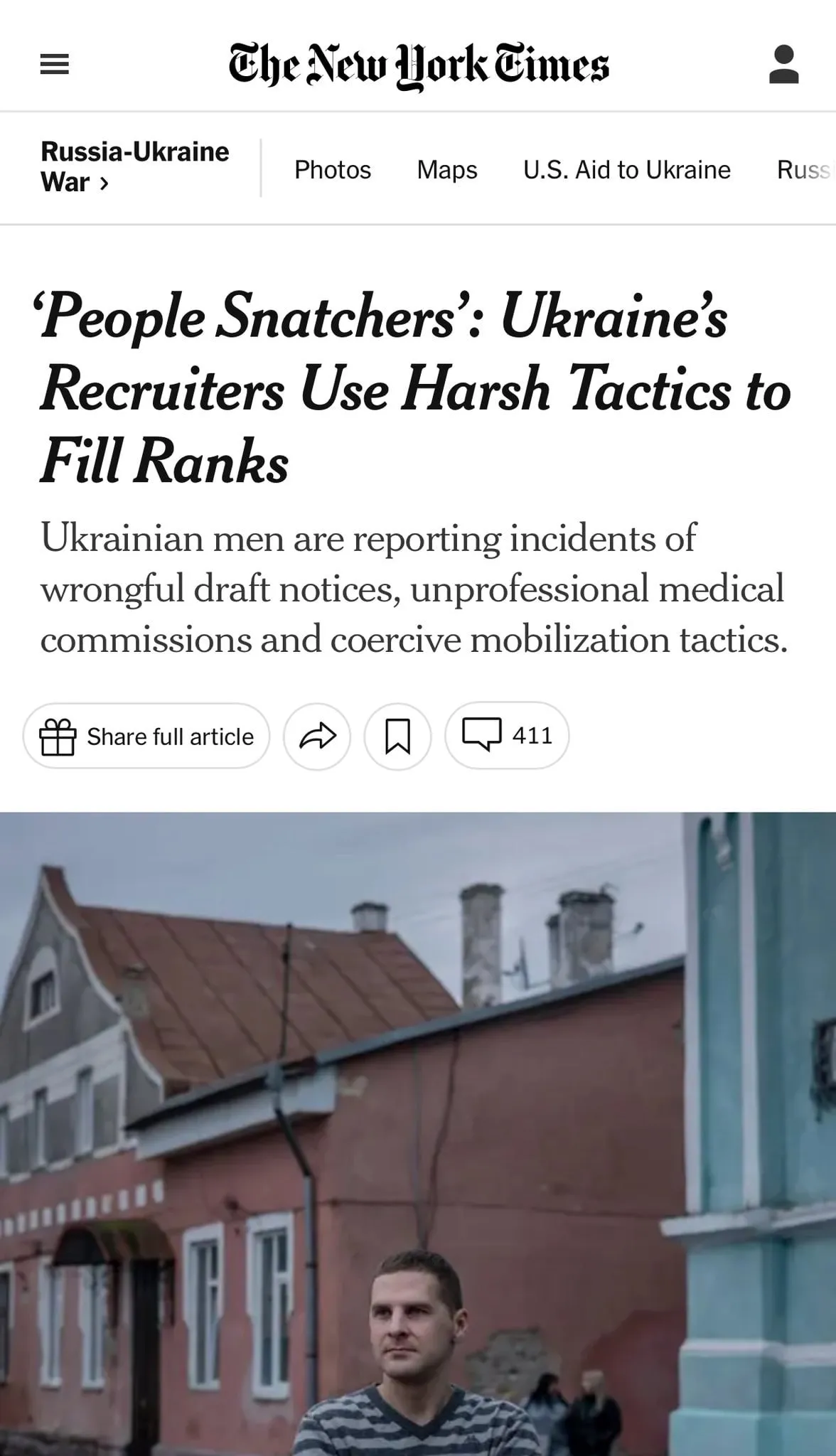
NYTimes brings us this stark highlight:
With Ukraine’s military facing mounting deaths and a stalemate on the battlefield, army recruiters have become increasingly aggressive in their efforts to replenish the ranks, in some cases pulling men off the streets and whisking them to recruiting centers using intimidation and even physical force.
In fact, this has been happening since the beginning, but it’s only now that MSM finally feels at liberty to reveal it. What next, they’ll start reporting on all the pole-tying saran-wrap incidents?
Times goes on to report that disabled people and even those meant to be exempt are all part of the recent corralling efforts, which sees AFU commissars steal their passports to keep them from running. The article highlights various intimidation methods and outright dead-of-night body-snatching:
These kinds of experiences have increased “massively in the last six months,” said Ms. Fefchak, the lawyer. At the beginning of the war, she said, there was no shortage of volunteer fighters. But in recent months, she has sometimes received 30 to 40 calls a day about men being forced into service. Other lawyers told of a notable increase in complaints.

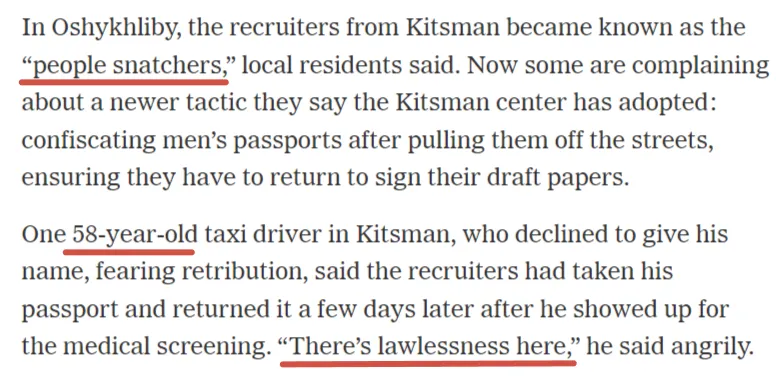
This report is particularly salient given that Ukraine’s GUR head Kiril Budanov just released his own damning admission about the current state of recruitment in the country, during a panel called “2024: Challenges and Prospects”: (Video at link.)
“We don’t have so many people willing to do anything. I’m not even talking about fighting, but this is current. There will be losses and this number must be maintained constantly,” added the head of the Main Intelligence Directorate. Now the effectiveness of forcibly mobilized Ukrainians is almost zero. This was stated by the head of the Main Intelligence Directorate Budanov.
“Everyone who wanted to came in the first six months. Who is being called up now? Unfortunately, there will not be a good answer here. If you don’t find motivation for these people, then how many people are not forced or according to the law, then their efficiency will be almost zero. What in principle, this is what has been happening lately,” Budanov said.
He believes that financial benefits for those mobilized are no longer in first place. “Most of our people, although everyone shouts “I am Ukrainian, Ukraine is above all,” have not felt themselves to be citizens of Ukraine. They do not have the feeling that the enemy has captured the territory and this is my sacred duty to defend this country. Everyone is rooting for Ukraine , but everyone is running,” added the head of the Main Intelligence Directorate.
He candidly admits that not only have mobilization pools dried up, with everyone who actually wanted to be there already having signed up in the first 6 months of war; but further, and more damningly, that the effectiveness of soldiers who were forcibly mobilized is ‘near zero’.
Recall what I wrote previously about how Ukraine’s number one issue is not necessarily rounding up the bodies themselves, it’s getting trained and motivated bodies who are capable of carrying out assaults. AFU commanders on every line are complaining that their soldiers are literally incapable of assaulting. Defending is much easier because it doesn’t require the same level of physical fitness or coordination.
The Times article above talks about a 58 year old being pulled off the street. What kind of assault can 58 year olds conduct? And the few assault-worthy brigades Ukraine has left are being sacrificed by criminal political orders to fight for useless symbolic objectives.
Which brings us to the second article, again from NYTimes, about the AFU Marines’ horrific struggles on the Dnieper front. In the last report I covered a BBC article about this same issue, but this doozy from NYTimes is even more eye-openingly forthright:
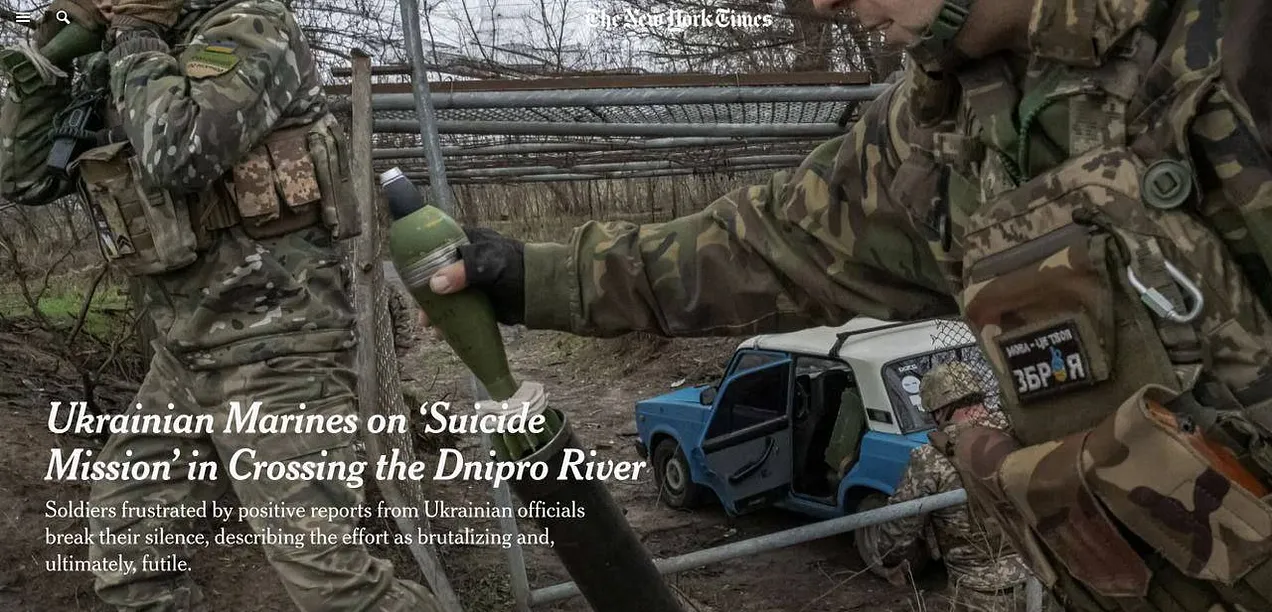
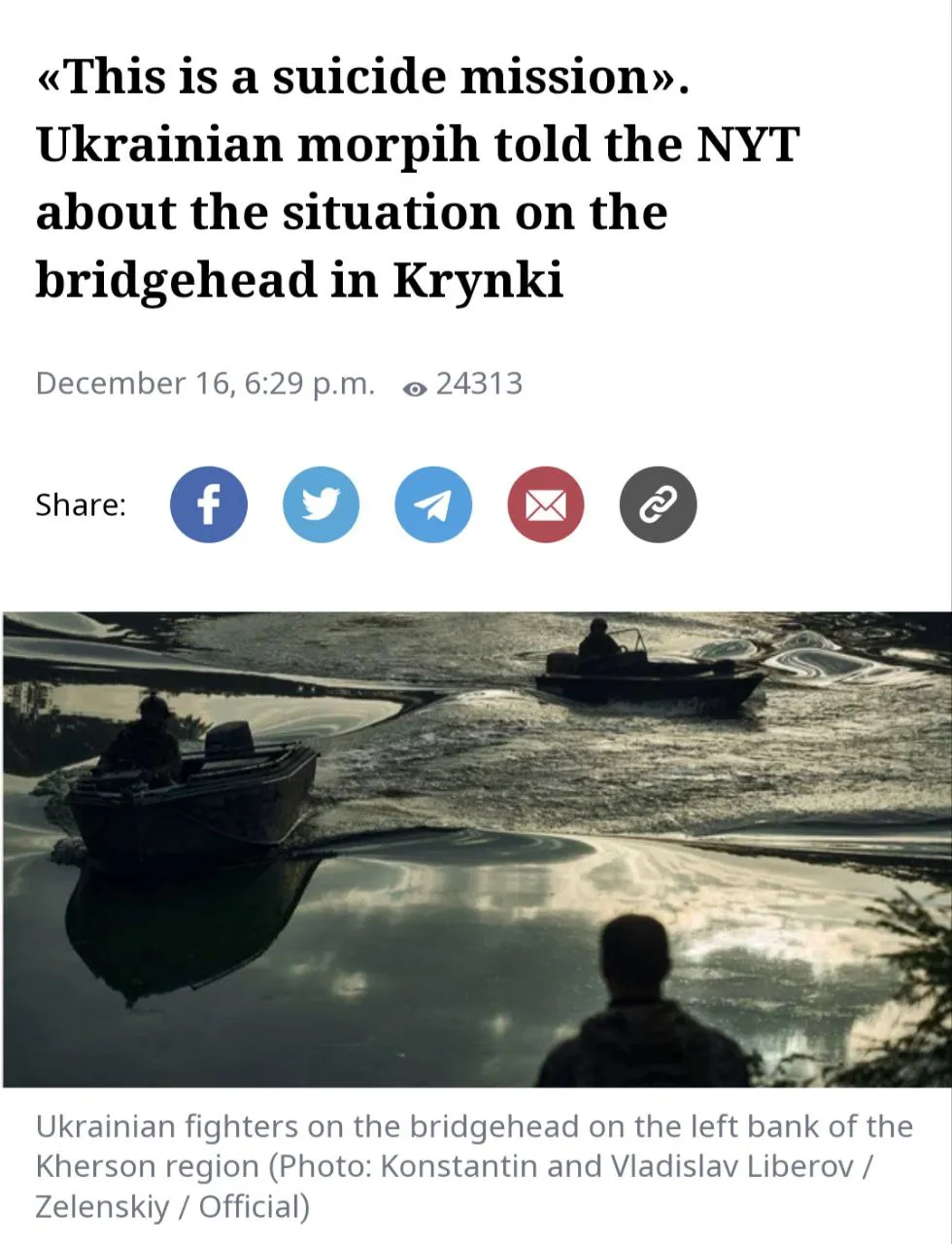
Just a few choice highlights:
Soldiers and marines who have taken part in the river crossings described the offensive as brutalizing and futile, as waves of Ukrainian troops have been struck down on the river banks or in the water, even before they reach the other side.
“We were sitting in the water at night and we were shelled by everything,” the marine, Maksym, said. “My comrades were dying in front of my eyes.”
Fresh troops arriving on the east bank have to step on soldiers’ bodies that lie tangled in the churned mud, said Oleksiy, an experienced soldier who fought in Krynky in October and has since crossed multiple times to help evacuate the wounded.
The Marines, who spoke under anonymity, confirmed that any putative ‘success’ in Khrynky is being overstated by their command; in fact, they consider it a pointless suicide mission to a place that doesn’t even have any real ‘positions’ to speak of:
“There are no positions. There is no such thing as an observation post or position,” said Oleksiy. “It is impossible to gain a foothold there. It’s impossible to move equipment there.”
“It’s not even a fight for survival,” he added. “It’s a suicide mission.”[/i]
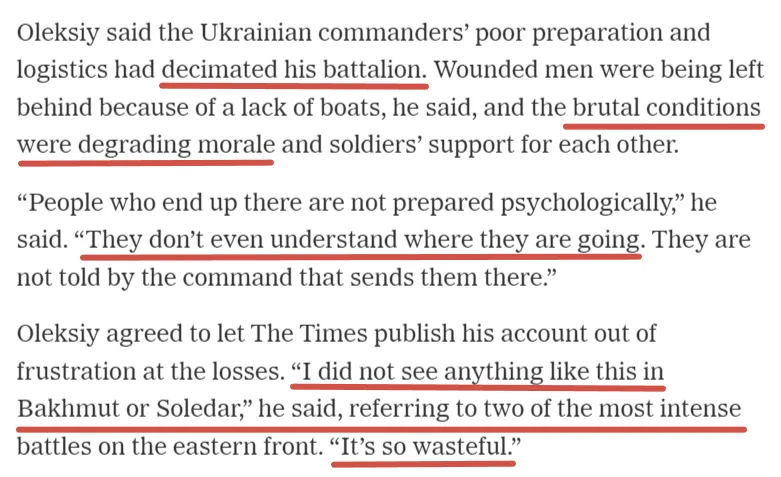
As validation to the article, just today a new post from an AFU-linked channel had this harrowing cry for help:
"I don't know if this will help or not anymore. But I will write it here once again! We are being exterminated by our own command. I am asking for help from everyone who can provide it. Knock on all doors, hold rallies and actions! Record a video! Do something. We are almost openly threatened with execution if we record videos ourselves and ask for help. Help us!
Krynkyi is a real hell. Mountains of corpses of our brothers. This will not end if everyone remains silent...
Reach out to the global community! It is useless to appeal to the country's authorities! They give the order for our extermination. They will not punish themselves.
I have found people who will be willing to translate your videos into English!
Record and send. It is necessary to reach the Hague International Court.
What is happening now is a crime against one's own people. Genocide of Ukrainians. I can't call it anything else.
As I’ve stated before, the only reason Ukraine continues to persist in this area is due to sunk cost fallacy, as well as a refusal to destroy credibility by ending the operation. They’ve already built it up so grandly that to abandon it now would be an admission of defeat almost equal to losing one of the prized cities, like Bakhmut or Avdeevka. So they’re now forced to squander on and continue exterminating some of their best units just to “keep up appearances” and keep the world from witnessing another massive, demoralizing setback which could kill the last bit of Western support.
The only question is, why now? Are these press outlets angling to draw attention and coverage to these horrors for the purpose of increasing aid at such a critical time? That’s probably likely, though there may be more to it, like the gradual campaign of tarnishing Zelensky in order to effect his ouster later.
The truth is, I almost didn’t cover it because it all feels so same-y after a while. I prefer to do reports that expand our awareness or understanding of new issues rather than treading the same ground, with the same dreary tales telling us things we’ve known for a long time. However, it does make the important revelation that much of Russia’s contentions are slowly being proven right as time goes by.
Many of these reports merely repeat what the Russian side has been saying for months—which they were heavily criticized and lampooned for.
It was “Russian propaganda!” to dare contradict that the valiant Marines were slaughtering all the orcs in Khrynky, and advancing day by day. It was “Russian propaganda!” to call into question Ukraine’s supposedly bottomless resource pool, and dare assert that the side taking a mere “15,000 total casualties”—as per Zelensky and co.—would ever begin to “run out of men.”
But suddenly we have it from ever-tight-lipped Budanov himself that not only does the Ukrainian society now lack willing able-bodied men, but that the body-snatched ones are effectively useless in real combat.
Lastly, there’s just one thing I wanted to highlight from this new CNN piece:

On the topic of major ‘sobering’ admissions, CNN quotes a senior US defense official as stating that Ukraine may not just suffer “setbacks” but total defeat by summertime:

When they blow the whistle like that, you know things have gotten dire.
They even admit again that Russian forces now regularly fire 5-7 times more shells than Ukraine:
Ukrainian forces are already rationing ammunition, US and Ukrainian officials told CNN, as Russian forces fire back at a ratio of five to seven times greater than Ukrainian forces are able to. A senior Ukrainian military official told CNN that Ukrainian commanders believe the impact on their firepower has led to additional Ukrainian casualties.
They state that Ukraine would first run out of long range missiles like Storm Shadows, then air defense, then artillery, citing the Storm Shadows in particular as having single-handedly pushed the Russian fleet away from Crimea and won control of the entire Black Sea for their grain corridor.
I keep hearing this narrative being spouted on the Ukrainian side. First of all—the Black Sea fleet wasn’t wholly pushed back anywhere, only some of its ships relocated to Novorossiysk, many if not most are still in Sevastopol and the ‘wunderwaffen’ missiles have yet to reach them.
Secondly, as I’ve stated before, the grain corridor has nothing whatsoever to do with Russian ships being pushed anywhere as Russia has never claimed they would “shut down” the corridor. Russia merely withdrew participation in the grain deal, implicitly allowing Ukraine to move its grain but under the warning to international shippers that the lane’s security can no longer be guaranteed with Russian protection. If Russia wanted to stop any ship moving there it could easily do so with an instant strike from a variety of platforms.
Once again, here’s a current livemap of maritime traffic in the region:
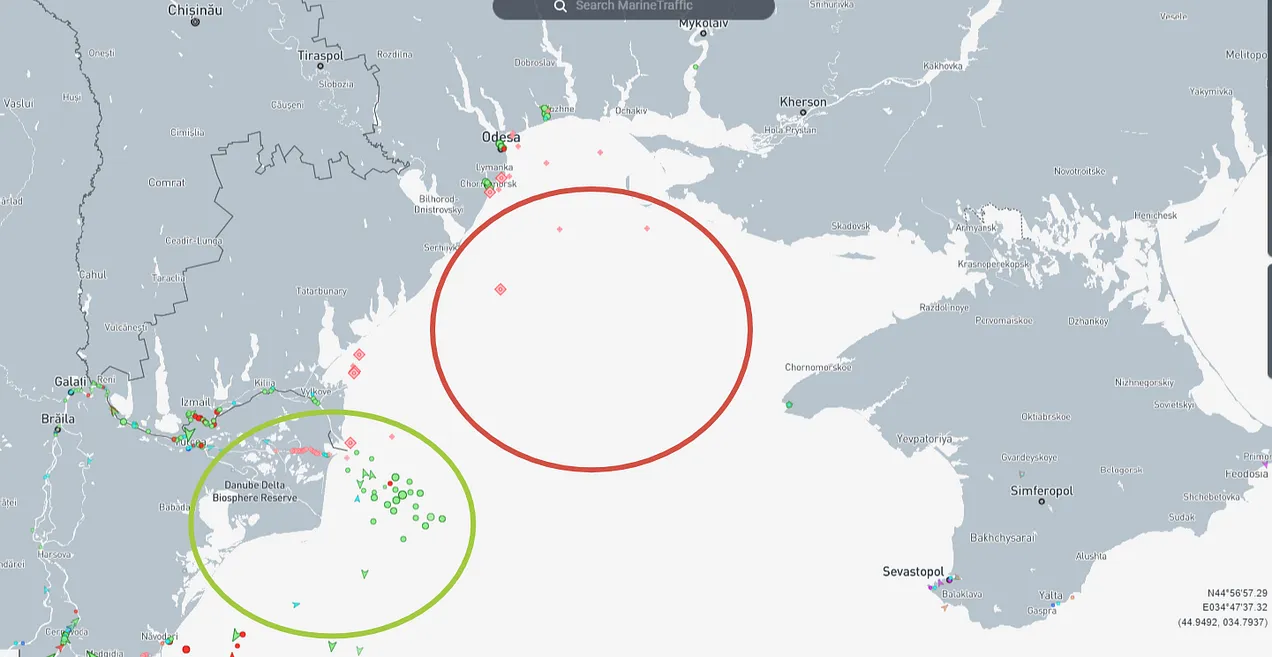
The red circle is the Odessa region, the green circle is already Romanian territory. Note the dozens of ships actively trafficking in and out of Romania, yet not a single ship visible in the waters toward Odessa (those red squares aren’t ships but are actually danger warning signs, maybe mines or other obstructions). That’s their miraculously ‘liberated’ grain corridor?
This broader view captures the lacuna more strikingly:
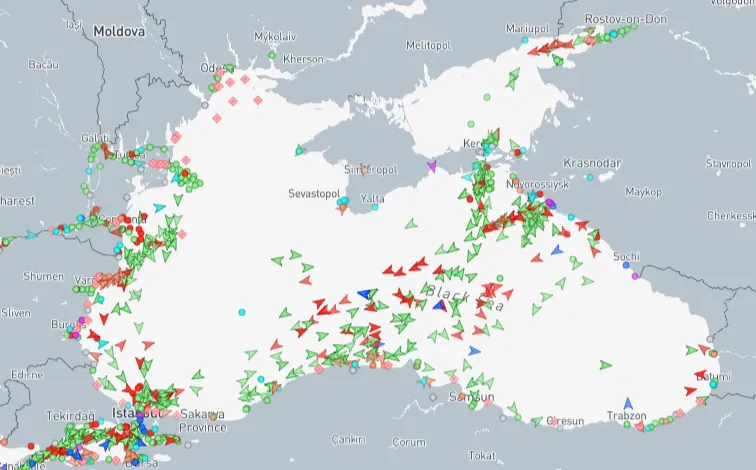
Every region has bountiful ship traffic except one. Yet we’re supposed to believe this is the heroically “liberated” region, according to CNN and Zelensky.
(Much more at link.)
https://simplicius76.substack.com/p/mor ... press-mill
*******
As Russia Signals It Can Achieve Maximalist Aims in Ukraine, How Would Russia Manage Kiev and Western Ukraine?
Posted on December 18, 2023 by Yves Smith
The West has made many bold pronouncements of its intentions for post-war Ukraine…of course, assuming a post-war Ukraine, starting with having Ukraine join NATO and the EU. And Russia has mainly ignored them and until of late, avoided making similar pronouncements. Russian officials had held to the mantra of pursuing the Special Military Operation until all its objectives were achieved. Russia has notably been closed-mouthed about how the war has been going, much to the consternation of some in Russia, who wanted to see Russia playing a more aggressive propaganda game.
So why is Russia acting in what would seem to be an out of character manner, telegraphing a maximalist view of what its Special Military Operation aims translate into when big funding packages in the US and EU are in play? Specifically, that if no one tries to come to a deal soon, Russia will install a more cooperative government, which translates into taking most or all of Ukraine. And Putin has even taken to giving more history lessons as to why Ukraine is at a minimum a branch of the Russian people and has declared Odessa to be a Russian city. 1
One would think Russia would be more circumspect. After all, pointing out what ought to be obvious is still more reality than the Collective West can bear right now. And there is a lot of “If we don’t give Ukraine more money and weapons, Putin will go to Paris” talk. Russian officials saying the end game will likely require more territorial, as in a lot more, can be spun as proof of those fears.
As we’ll discuss shortly, absent a wildly unexpected development, Russia has the capacity to subdue all of Ukraine by force. Normally cautious Russian officials are effectively saying that to Russian citizens, even at the risk of further provoking the US and NATO. That is likely because they know full well what some Western commentators have pointed out, that the West simply cannot begin to compete with Russia in arms production, even before getting to the superiority of Russian systems in most categories. Despite recognition of that sorry fact in some quarters, the West is not making serious efforts to rearm or increase manning levels. And a second, more critical factor with respect to Ukraine is it has burned through nearly all of its experienced soldiers, and is falling short of filling the ranks with new conscripts, who wind up being cannon fodder.
But does the new Russian open show of confidence merely reflect its ability to prostrate Ukraine? Or could it also mean Russia also believes it has come up with solutions to another big problem we flagged from the outset, “winning the peace”? Occupying hostile territory is costly and corrosive. How does Russia plan to get in sufficient good graces with the population in the largely-ethnically Ukrainian west Ukraine?
Towards the very end of this post, we’ll also sketch out how Russia can hoist the West a bit on its sanctions petard and even potentially use other people’s money and assets to win new friends.
How Western Continuing Refusal to Consider Russian Security Needs Means Russia Will Take Matters Into Its Own Hands
Remember that the Collective West has doggedly maintained that it will keep fighting Russia in Ukraine, even if how exactly it will do so looks increasingly in doubt.
For instance, recall how Tony Blinken, in a Washington Post interview with David Ignatius in January, was already thinking about what would happen after Ukraine won…and made clear the US would keep arming Ukraine so as to contain and weaken Russia.2
As Ukraine is now visibly losing the war, the response from the West has been more threat display, such as Lloyd Austin saying that in November the US must not let Russia win, otherwise in a new variant of domino theory, China will be emboldened in Asia. And of course Putin will soon eat up the Baltics too.
We will spare readers more examples of key Western officials saying, no way, now how will they let Russia “win” in Ukraine, whatever that might mean. It was conceivable that if Russia were to stop, say at the Dnieper, that would have been spun as a Western success since Russia would be depicted, contrary to evidence, as wanting to take over all of Ukraine.
But as Western leaders continue to be unrealistic about the state of play, most importantly, showing zero interest in negotiations between Russia and the US, Russia not only will determine the end game (something that was pretty much a given), rationally, Russia needs to take a ruthless view of how it creates new facts on the ground in the territory of Ukraine so as to impede further Collective West action and meddling.
Russian citizens criticized their government, particularly early in the war, for its weak propaganda efforts. But it looks to have played the smarter long game, with considerable diplomatic out-reach and exploiting Collective West inattention to the considerable cost of sanctions blowback on many developing economies.
So it is noteworthy that in the last month of so, Russian leaders, starting with Putin, have been saying in a not very coded manner that if the West does not come up with a way to addressing Russia’s security needs, Russia will settle the matter by force. That increasingly looks like it will include Odessa becoming part of Russia and Russia defeating and replacing the government in Kiev.1
Recall as we wrote a month ago:
This is why both Putin and Medvedev suggesting Kiev might be part of the equation would seem to be a significant shift. There are lots of maps of electoral results that Western pundits have used as proxies for ethnic Russian versus ethnic Ukrainian representation. This one from the Washington Post is indicative. You can see Kiev is most assuredly in a European-leaning part of the country, as if that were in doubt:
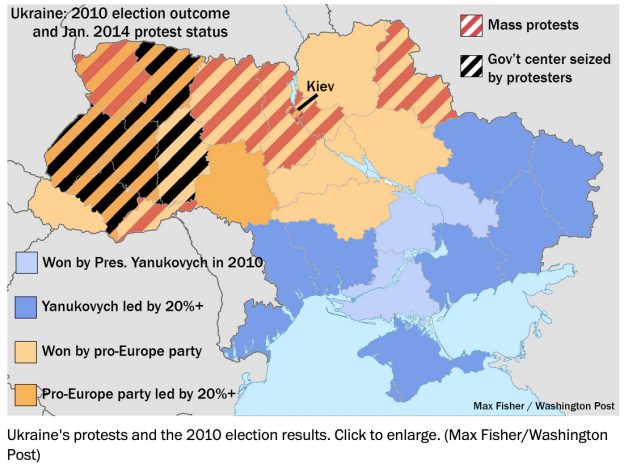
But in Putin’s November 3 speech, he described long form as to how Russia has claims on “Ancient Rus” and that would seem to include Kiev2:
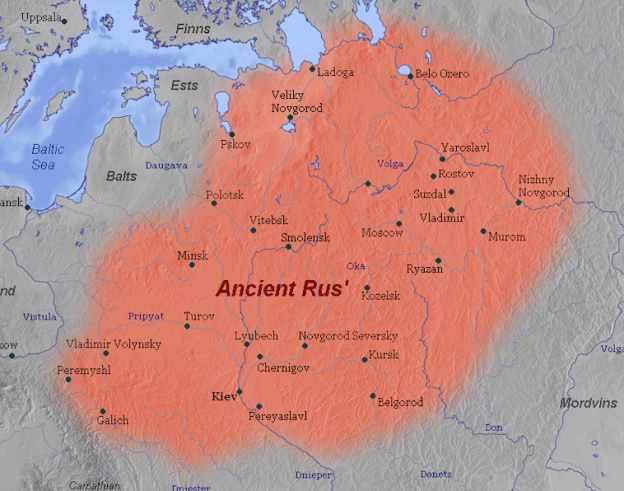
Admittedly Western officials have taken to flogging the “Russia wants to occupy Europe” trope to insist that more more money must go into the Ukraine burn pit. But there’s no indication that that messaging is in response to Putin, Medvedev and other officials taking a harder line about the Ukraine end game. It instead seems to be a reptile-brain reflex to realizing that the Great Counteroffensive was a big bust. Even if West has no new rabbits to pull out of its hat, throwing more money at the problem will do as a temporizing response.
Has Russia Become More Confident Not Just About the War but Also About the Peace?
It is striking that Russia is preparing the Russian public for an end game for Ukraine that includes Russia taking a lot more territory than earlier contemplated, and is saying that now, when further Ukraine funding is in play in the US and Europe. Perhaps I am reading too much into what I can infer at this distance, but the change in messaging is marked enough that it appears the Russian government came to some decisions and the start of presenting what the post war map might look like is a reflection of that.
One has to wonder if Russia’s shift is a reflection not just about its ability to fully prostrate Ukraine if it needs to, but also having gotten or developed information that indicates that controlling Western Ukraine, if it comes to that, will not be unduly costly. That could be the result of assessments like:
Estimates of the able-bodied adult population that lives in non-ethnic Russian dominated Ukraine
Continuing success in military enlistments, meaning Russia has more than enough men and women to handle peace-keeping and critical reconstruction
Estimates of how many more Ukrainians will flee when its borders are reopened3
Ukraine has engaged only in pinprick-level terrorism, and Russia believes it can’t inflict meaningful harm4
Because this post is already long, I will merely introduce an idea I hope to develop further. What happens to Ukraine’s assets and liabilities?
Let’s start down this line of thinking. If Russia gets Ukraine to surrender, or otherwise achieves regime change without US involvement, it is not hard to think the US and the EU will quickly extend the Russian sanctions to Ukraine. The hope would be to collapse its banking system.
But as far as I can tell, the foreign debt of Ukraine banks is only $1.8 billion. Private external debt seems to lie mainly in other sectors. So Russia could without much outlay prop up the banks if needed. But that would or should mean it also means the Russian Central Bank becomes their regulator, and the entire banking system is under new oversight and rules.
More interesting is the opportunities that a move like this might open up. Recall that Ukraine refused to renew the Treaty on Friendship, Cooperation, and Partnership between Ukraine and the Russian Federation in 2019, so it expired in March. That treaty, by the way, is the one by which Russia recognized the invoilability of Ukraine’s borders, respect its territorial integrity, and otherwise not harm Ukraine’s national security. So Russia has no current treaties with Ukraine at Ukraine’s instigation, particularly with respect to important matters like not invading.
The fact that Russia and Ukraine stopped recognizing each other as sovereign states means Russia has no obligation to act as a “successor” to any Ukraine private or government commitments.
Now if the Collective West were to predictably and reflexively sanction a new Ukraine government, its currency would no longer be accepted in the West for payment. More importantly, Western banks would presumably be barred from remitting payments to Ukraine banks.
Now things get fun!
So pray tell how does Ukraine satisfy its foreign debt obligations when it has been frozen out of the Western payment system? We’re looking at you, IMF.
How do Ukraine asset owners, like rich Ukrainians who fled to Europe, pay taxes on their real estate in Ukraine? On the agricultural land in foreign hands?
What happens if Russia decides, arguably to rescue Ukraine, but of course also to limit its sovereignity, to put Rump Ukraine on the rouble?4 Operationally this would be trickly but since the economy is already in a state of collapse, the usual concern about downside would be moot.
Now of course Russia being very keen about observing legal forms would presumably allow Ukraine asset holders to use any deposits in Ukraine banks to pay tax and other government fees and charges. But Russia can easily use well established banking tricks practices not to make it easy. For instance, in the US, if an account is compromised, the owner must make an in-person appearance in the branch with valid ID to prove it is indeed his account in order for it to be unfrozen. Russia or its proxy Rump Ukraine could similarly require at least one in-person visit from foreign account owners for them to continue to have access to account access. Recall it is also normal for accounts that have been inactive for a certain period of time to be escheated to the state.
In other words, one could anticipate that at least some, perhaps many, assets owned by foreigners in Ukraine would be seized due to unpaid taxes. Russia /Rump Ukraine could auction them to the highest bidder…or for residential property, distribute it by lottery with people disabled in the war (from both sides) and other groups getting preference. Similarly agricultural land could be distributed according to a formula (particularly preference given to family farmers).
So there could be a path to using assets in Rump Ukraine, where the West would have created conditions for their owners to be unable to meet their legal obligations and therefore lose title to them, to then be redistributed in ways that would create good will toward the new Russian overlords.
Readers?
____
1 From a recent press and public Q%A session, Results of the Year with Vladimir Putin on December 14, which as Gilbert Doctorow pointed out, did not present anything new, although some of his themes are pretty recent:
There will be peace when we achieve our goals, which you have mentioned. Now let’s return to these goals – they have not changed. I would like to remind you how we formulated them: denazification, demilitarisation, and a neutral status for Ukraine.
Look what is happening in terms of denazification. During the negotiation process, there was a certain stage after the drafting of a possible agreement, which was recently mentioned by officials in Kiev, where, in general they did not agree that some kind of denazification was needed, and they said that there was no fascistisation, no growth of such sentiments…
And when the head of today’s Kiev Administration in front of the whole world gives a standing ovation to a former SS soldier who directly participated in the Holocaust, in the extermination of 1.5 million Jews in Ukraine, Russians and Poles. Is this not a manifestation of Nazism? Therefore, the issue of denazification is relevant. It is true that during the negotiation process we, our negotiators, were told that in principle they did not rule out the possibility of adopting some legislative acts in Ukraine. That was then, during the negotiations in Istanbul.
Now, as for demilitarisation. If they do not want to reach an agreement, then we have to resort to other measures, including military ones….By the way, they got everything as promised. Ukraine received everything, and even more than what was promised by the West. But ever since the start of the so-called counteroffensive, we have destroyed 747 tanks. This is as of yesterday evening. We have also destroyed almost 2,300 armoured vehicles of various types. This is what is called demilitarisation. Alternatively, we can agree on demilitarisation and establish certain parameters. We actually agreed on them during the Istanbul talks, although these agreements were thrown out later, but we managed to reach agreement. There are also other possibilities to either reach an agreement or resolve the conflict by force. This is what we will strive for….
As for normalising relations [with Europe], it does not depend on us alone….
How did the conflict in Ukraine begin? Let us look back, even though it may take three or four minutes. It began with the state coup in Ukraine in 2014…
Do you see the core of the problem? The problem is, as I have always said and as I am saying today, that despite the current tragic developments, Russians and Ukrainians are essentially one people. What is happening now is an immense tragedy; it is like a civil war between brothers who stand on different sides [of the conflict]. But overall, they are not, to a large extent, responsible for this.
The southeastern part of Ukraine has always been pro-Russian because it is historically a Russian territory…Crimea nor the Black Sea region has any connection to Ukraine. Odessa is a Russian city. We know this. Everyone knows this. But they [Ukrainians] have concocted some historical nonsense….
But after the 2014 state coup, it became clear to us that they would use force to prevent us from developing normal relations with Ukraine. They spent US$5 billion on that state coup, as the Americans openly admitted, without any hesitation…
That, combined with a burning urge to creep up to our borders and drag Ukraine into NATO – all of this has led to the tragedy. In addition, there has been bloodshed in Donbass for eight years. All this taken together has led to the tragedy that we are now experiencing. They forced us to take these actions.
So, as I say, in a situation where the United States conceived and orchestrated this act with Europe standing by and averting its gaze, or playing along and singing along with them, how can we build relations with them in these circumstances? We would – we did not break off any ties – but they pretend they do not know or remember anything. Only two or three times did they mention the Minsk agreements, saying they were not for real and were never going to be implemented. In 2014, they also signed those guarantees, those agreements between the government and the opposition in Ukraine just like that, and immediately forgot about them or threw them away.
Do you see my point? My point is that they have lost their sovereignty to a large extent, as we can see now, and they are making many decisions to their own detriment. To their own detriment! But they do it, nonetheless…
In fact, we are ready to build relations with the United States as well. We believe that America is an important country on the world stage. But this absolutely imperial policy the country pursues is bad for them, not even for us…
As soon as they change on a deeper level, and begin to respect other people, other countries, start searching for compromises instead of addressing their problems using sanctions and military force, which would create the underlying conditions for restoring full-fledged relations. So far, there are no such conditions. But we are ready for this.
2 From the article Blinken ponders the post-Ukraine-war order:
The Biden administration, convinced that Vladimir Putin has failed in his attempt to erase Ukraine, has begun planning for an eventual postwar military balance that will help Kyiv deter any repetition of Russia’s brutal invasion….
Russia’s colossal failure to achieve its military goals, Blinken believes, should now spur the United States and its allies to begin thinking about the shape of postwar Ukraine — and how to create a just and durable peace that upholds Ukraine’s territorial integrity and allows it to deter and, if necessary, defend against any future aggression. In other words, Russia should not be able to rest, regroup and reattack.
Blinken’s deterrence framework is somewhat different from last year’s discussions with Kyiv about security guarantees similar to NATO’s Article 5. Rather than such a formal treaty pledge, some U.S. officials increasingly believe the key is to give Ukraine the tools it needs to defend itself. Security will be ensured by potent weapons systems — especially armor and air defense — along with a strong, noncorrupt economy and membership in the European Union.
The Pentagon’s current stress on providing Kyiv with weapons and training for maneuver warfare reflects this long-term goal of deterrence. “The importance of maneuver weapons isn’t just to give Ukraine strength now to regain territory but as a deterrent against future Russian attacks,” explained a State Department official familiar with Blinken’s thinking. “Maneuver is the future.”
3 From Almayadeen in August:
But this is a regime that has banned all men between the ages of 18 and 60 as well as women in certain professions from leaving the country. There is no free internal movement of citizens. The main exceptions to the prohibition on leaving the country are those unfit for military service, those fathers who have three or more minor children (all below the age of 16), and persons caring for people with disabilities. (The latter exemption only applies if there is no other family member to provide care.)
4 The counterargument is that the US prevented Ukraine from doing much. However, my impression is the sensitivity involved using US/NATO weapons and intel. Stunts like the fertilizer-truck bomb attack on the Kerch bridge, and the recent strike on a Russian train line in Siberia, can be depicted, as the case may be, as Putin-haters acting on their own or the SBU acting on its own. So Ukraine does have autonomy on this front and Russia may have deemed what it (or more accurately, dissidents after the war is over) can do as a manageable risk.
5 The US didn’t try that with Japan, where the US imposed a new Constitution and limited its military to self-defense (that has become a bit of a fiction in recent decades) but the world was on the Gold Standard then plus…Japan used Japanese, and just about no one in the West could read it, which translated into an inability to oversee banking. Even in Peak Japan in the 1980s, the number of Westerners who could read Japanese was remarkably small.
https://www.nakedcapitalism.com/2023/12 ... raine.html
Whadda worrywart....I'll bet 50 cent that Russia is intent upon no more than old NovoRussia, the arc from Kharkov to Odessa. The rest can remain an impotent neutral. Who would want Galacia anyways? Let the Poles have it, they deserve it.
******
The Financial Times Is Spinning Ukraine’s Defeat As A Victory To Justify Freezing The Conflict
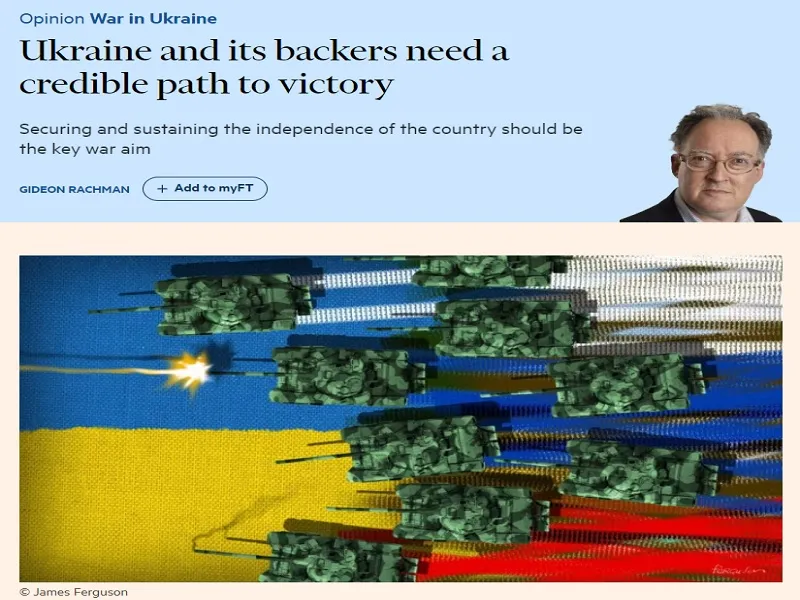
ANDREW KORYBKO
DEC 19, 2023
Their chief foreign affairs columnist’s claims that Ukraine can replicate South Korea’s economic success due to its continued access to the Black Sea, his hyping up of exaggerated reports about Russian losses, and praise for Ukraine’s continued existence as a state are meant to justify freezing the conflict by sometime next year.
The Financial Times (FT) was surprisingly candid in their latest piece about how “Ukraine and its backers need a credible path to victory”, whose title masks the fact that it’s all about spinning that country’s defeat as a victory to justify freezing the conflict. This isn’t a subjective interpretation of its intent like some skeptics might reactively claim but was explicitly stated in the piece after a former US official was quoted near the end as saying that “We have to flip the narrative and say that Putin has failed.”
FT’s chief foreign affairs columnist Gideon Rachman spent most of his article up until that point impressively dispelling the targeted Western audience’s misperceptions about this conflict. The counteroffensive failed, Western aid is being curtailed as a result, and Ukraine is now bracing for a Russian offensive. In other words, the conflict is winding down, which led to a surge of interest in former NATO Supreme Commander Admiral James Stavirdis’ “land-for-peace” proposal from early November.
Rachman references that Korean-like armistice scenario without attribution in his piece, after which he then cites that abovementioned former US official amidst his own efforts to spin Ukraine’s defeat as a victory in order to make that outcome more palatable for the Western public. To that end, he claims that Ukraine can replicate South Korea’s economic success due to its continued access to the Black Sea, hypes up exaggerated reports about Russian losses, and praises Ukraine’s continued existence as a state.
The combination of these three is intended to “flip the narrative and say that Putin has failed” even though it’s objectively the case that Ukraine’s counteroffensive failed and therefore ruined Zelensky’s messianic delusions of maximum victory over Russia that Time Magazine was the first to report about. The West had no Plan B for if the counteroffensive failed, which is why the “land-for-peace” scenario looks likely, unless the ever-present risk of a false flag for rekindling NATO-Russian tensions takes shape.
Ukrainian Foreign Minister Dmitry Kuleba was recently panicking about any such peace deal and sought to desperately discredit it in his latest article for Foreign Affairs magazine by describing that scenario as “defeatist”, but a recent piece by Politico earlier in the week hints that the writing is on the wall. A senior fellow from the Atlantic Council, which is one of the US’ most influential think tanks, demanded in that popularly read Beltway publication that Zelensky form a “government of national unity”.
The walls are obviously closing in on him after his refusal to comply with the West’s reported pressure to recommence peace talks with Russia aimed at preemptively averting any potential breakthrough that could either end in Kiev’s full defeat or prompt a dangerous NATO intervention to establish “red lines”. The signal being sent by the American Establishment through that Politico piece is that he needs to gradually exit the stage in a ‘face-saving” way in order to facilitate that outcome or risk being replaced.
Even in the event that Commander-in-Chief Valery Zaluzhny comes to power for example and expresses a willingness to formally resume such negotiations, however, it can’t be taken for granted that Russia will accede. President Putin reaffirmed in his annual Q&A last week that the conflict will continue until his country’s goals of denazifying Ukraine, demilitarizing it, and ensuring its military neutrality are achieved. He’s still open to a diplomatic solution but said that Russia will resolve the conflict by force if needed.
Russian Foreign Minister Sergey Lavrov echoed his boss earlier this week. According to him, “[The experts that he met with while in New York City last spring] did not hesitate to say that Ukraine needed time to improve its situation in terms of stocks, military equipment, missiles and other warfare items. That was in April. Today, Western leaders are openly talking about it, making the same proposals and making it clear that this would not be an end to the conflict but a pause.”
Esteemed Russian expert Vasily Kashin told RT in a recent interview that the West’s “primary political goal” is “Forcing Russia to agree to a truce along the existing line of contact without any obligations on Ukraine’s part, a situation that may lead to the rearmament of the Ukrainian army and Kiev’s accession to NATO. This would allow the West to continue using Ukraine to pursue its anti-Russian policy and, if necessary, to start a new war in a few years, which would be very difficult and dangerous for Russia.”
Seeing as how the political leadership, diplomatic leadership, and leading academics are all on the same page about this scenario, it’s unlikely that Russia would accept a simple “land-for-peace” deal without significant military strings attached to Ukraine in exchange. With the conflict’s dynamics having shifted back to Russia once again preparing for an offensive due to its victory over NATO in the “race of logistics”/“war of attrition”, there’s little reason for the Kremlin to accept a bad deal.
Considering this, the West’s latest spin campaign will have to go into warp speed in order to convince their targeted audience at home that any such security-related concessions to Russia that would be required by Moscow for freezing the conflict as was just explained still amount to a so-called “victory”. It’s here where the recently reported declassified US intelligence assessment that was provided to Congress and shared with CNN comes into narrative play.
That document ridiculously claimed that “Russia has lost a staggering 87 percent of the total number of active-duty ground troops” that it had prior to launching its special operation, which is intellectually insulting to allege but might nevertheless still be believed by their targeted Western audience. In that case, they might not be all too worried about such concessions to Russia if they’re misled to believe that Biden jumped the shark when he warned the other day that it’s supposedly plotting to attack NATO.
The mixed messages coming from the American Establishment right now as evidenced by the president’s statement, that declassified US intelligence assessment, and the Atlantic Council’s national unity government demand to Zelensky that it made via Politico suggest that debates are ongoing. Even so, the writing is still on the wall in more ways than one since the West has soured on Zelensky and might agree to security concessions for a “land-for-peace” deal, though both might take some time to materialize.
https://korybko.substack.com/p/the-fina ... g-ukraines

